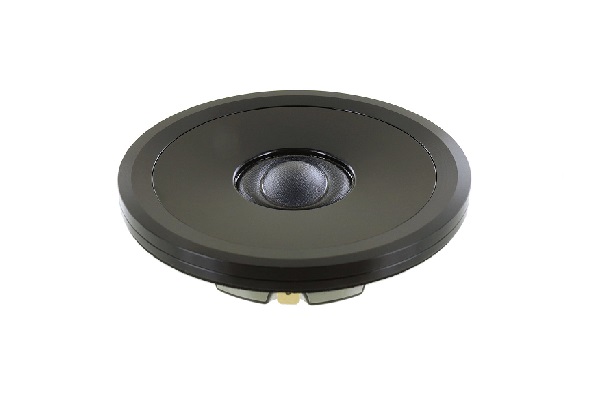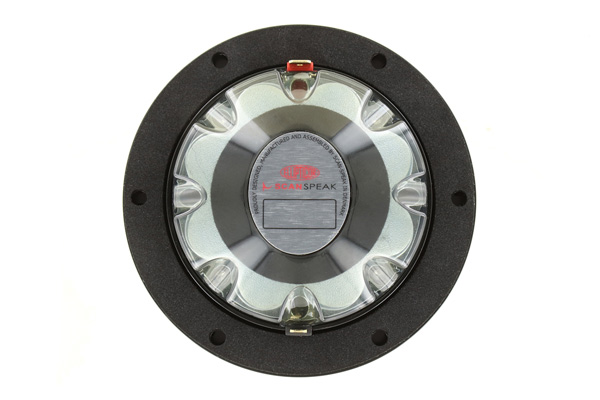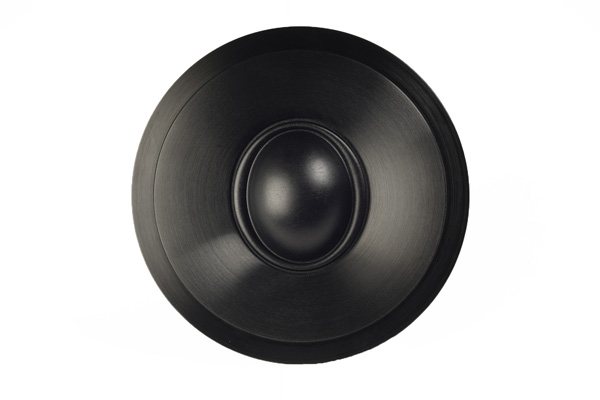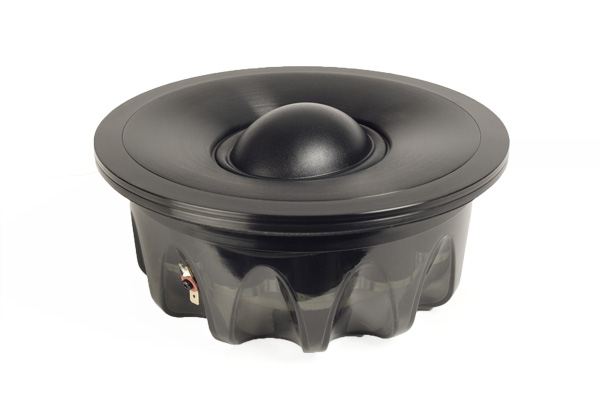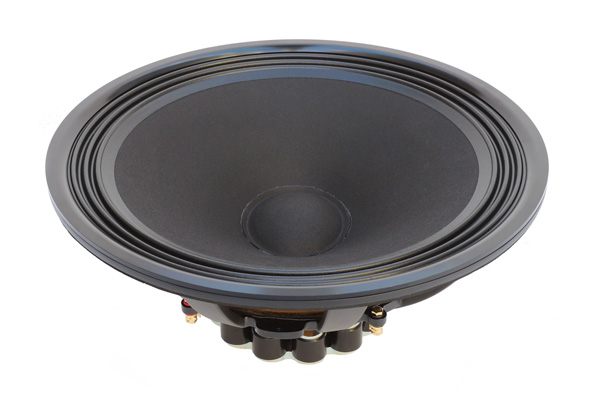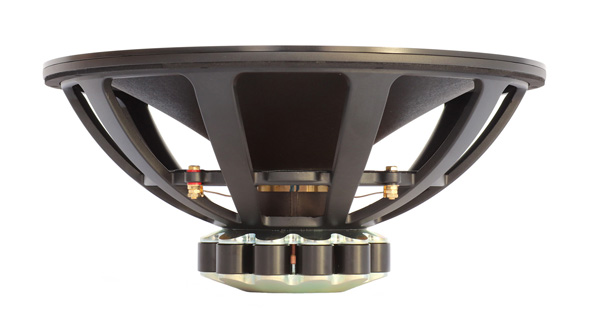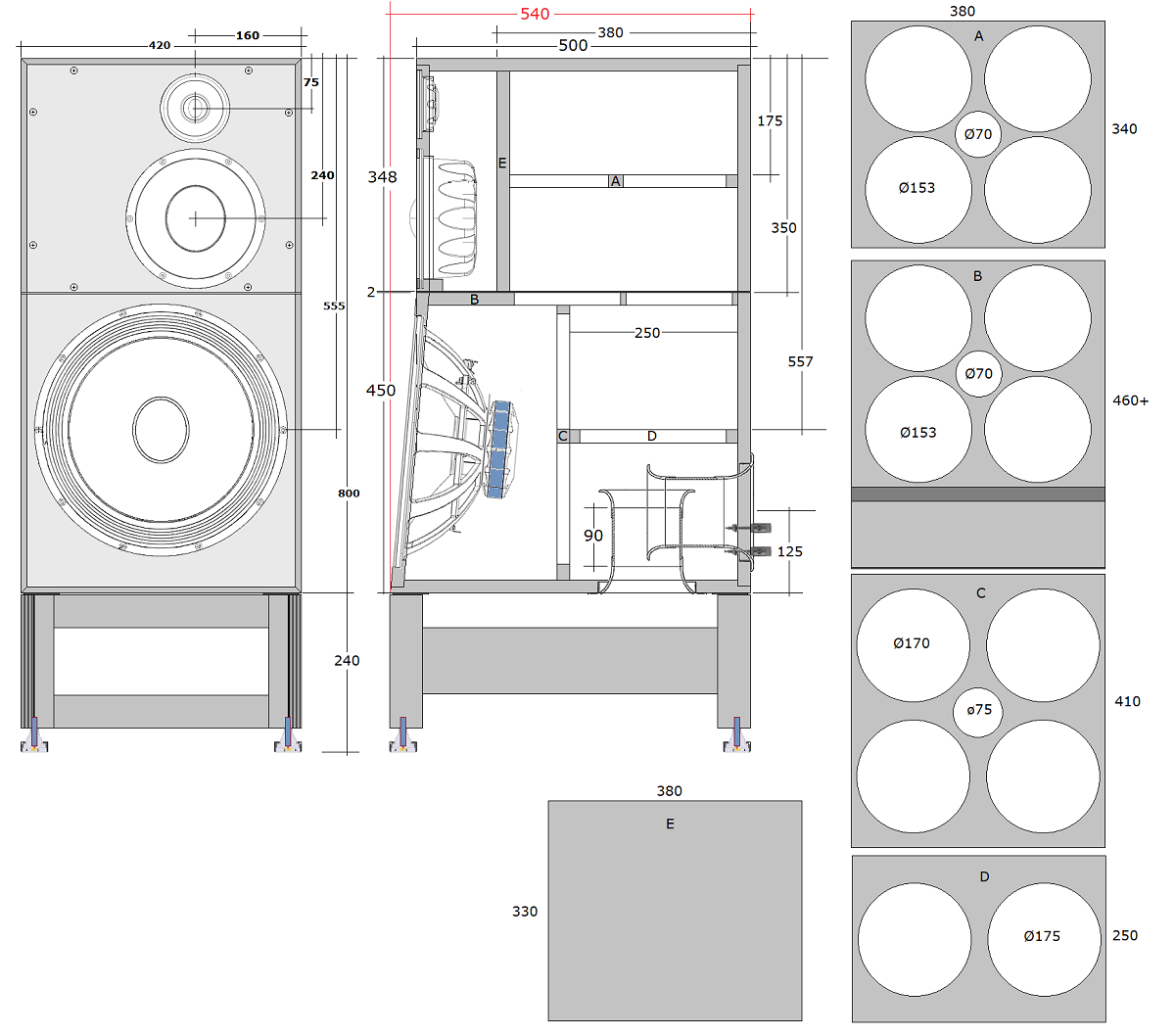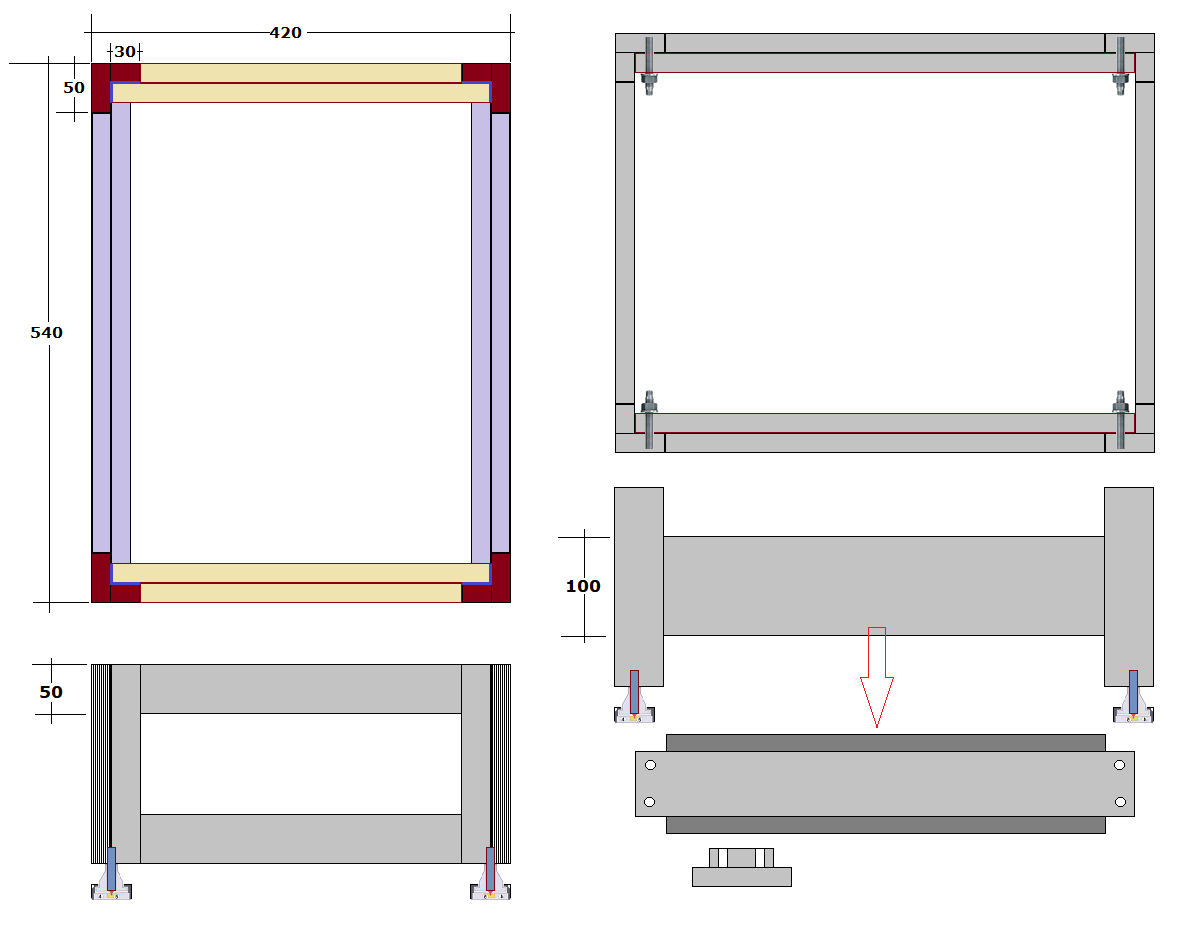ScanSpeak
Ellipticor-84
Copyright 2023 © Troels Gravesen
Go to on this page:
DRIVERS CROSSOVER CABINET WORKSHOP PICS MEASUREMENTS
SPEAKER-KIT CROSSOVER LAYOUT STANDS
Well, it had to be done. Mating a large bass driver with a large
midrange dome. Nothing new under the sun, but very little used. I guess
Acoustic Research was the first to do it with their legendary AR3a
speaker featuring a 12" bass driver handing over to a 1½" mid-dome from
around 575 Hz according to specs. I never heard the AR3a, but a friend
of mine still have his AR11s with pretty much the same drivers - and it
does well - after I re-foamed his bass drivers.
Best known today for this layout of drivers is ATC with their well
regarded range of studio/home speakers featuring the magnificent 3"
double spider mid-dome. British VOLT produce a couple of (single spider)
mid-domes, one 2" and one 3". Most recent addition to the limited
range of mid-domes is the SBAcoustics MD60N-6, which I tested in my
SBA-7MD construction - and I very much liked what I heard. I just
learned Yamaha launched a new speaker with a 3-1/4" mid-dome, so maybe
we'll see more mid-domes in the future - and I certainly wouldn't mind.
Last year ScanSpeak released their D8404/552000 mid-driver, a
one-of-a-kind mid-dome with elliptical voice coil of 84/68 mm
- and double spider. Never seen before and partly due to corona I spent almost two years with
the prototypes before final release at the Munich HighEnd show. And
suffice to say, I had some good times with the "D84", which resulted in
the
Ellipticor-A50-mkII.
Now, in mating a bass driver to the D84, we should most likely not look
for some heavy
subwoofer type, rather a driver with a more light-weight cone with the
ability of playing some midrange, possibly all of the midrange, although
we're not going to take advantage of this.
I have two 83 liter test
cabinets and here the merged response (200 Hz) of the 38WE driver:
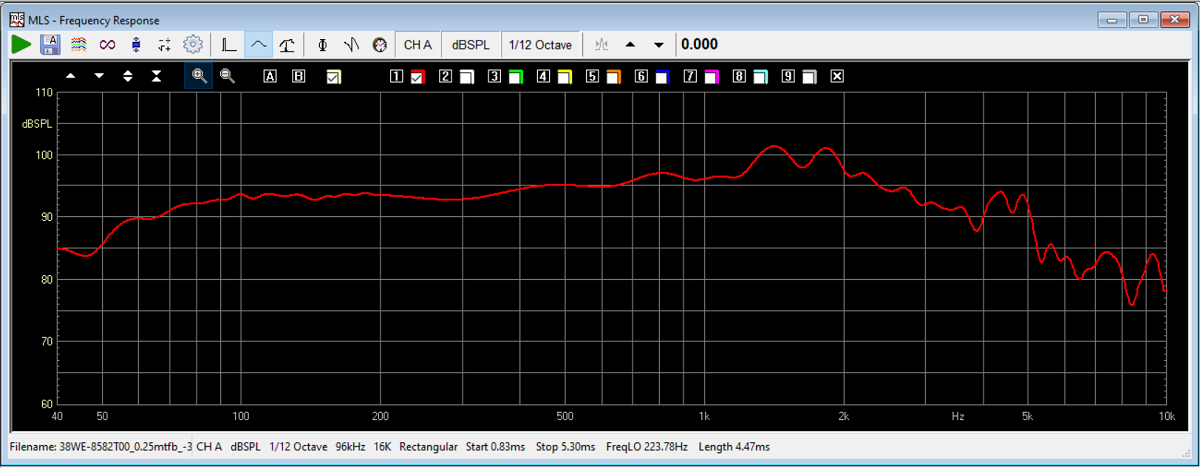
This 15" driver works really well up to around 1200 Hz. More than enough
for our purpose with an intended point of crossover around 375-400 Hz.
Based on preliminary tests, we can achieve a system sensitivity around
92-93 dB. On an infinite baffle we may hit some 95 dB, but this is of no
use in real-world cabinets - even with some room-gain. Room gain is the
necessary evil and as a designer I can only guess where the speakers
will be placed. The Ellipticor-84 is intended - like all my speakers -
to be somewhat out on the floor having modest room-gain, maybe 1-2 dB.
At 400 Hz we have a wavelength of some 85 cm, so phase issues
(time-alignment) is of minor importance between bass and mid-dome and
the D24 and D84 has very much the same acoustic depth, so we can use a
flat baffle like the A50.
The two mid-domes look like this and we have a suitable range to below 300 Hz and up to around 5000 Hz, some 4 octave. Nice!
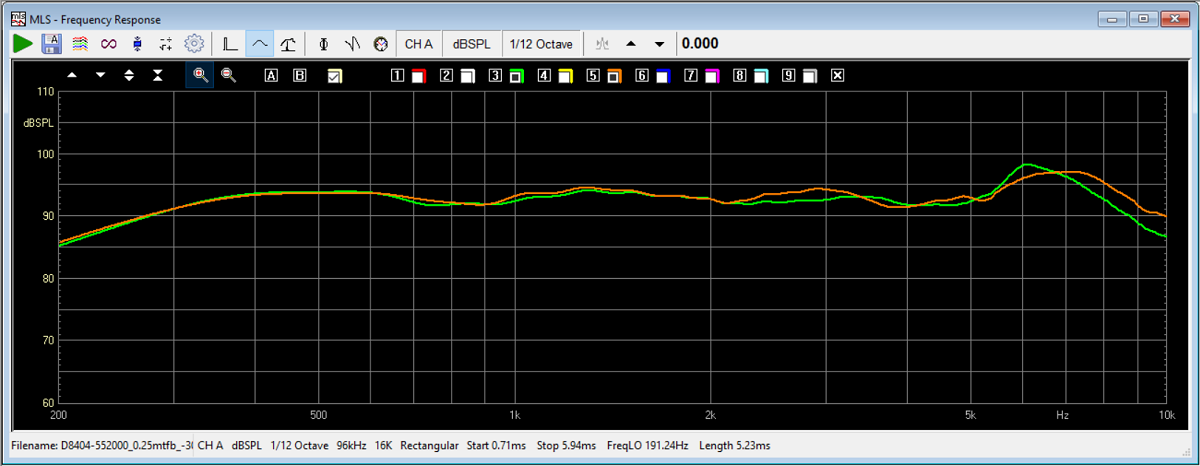
Below you can see my workshop mockup and I really wasn't prepared for my 32 wpc tube amp to deliver the dynamics I heard. It can play insanely loud from only 32 watts and I guess the high impedance in the bass partly counts for this. The crossover is different from my A50s - but not much, just found an easier way to roll-off the D84 towards the tweeter. Doing the basic measurements and crossover simulation took some time, but here the D84/D24 compo driven from crossover:
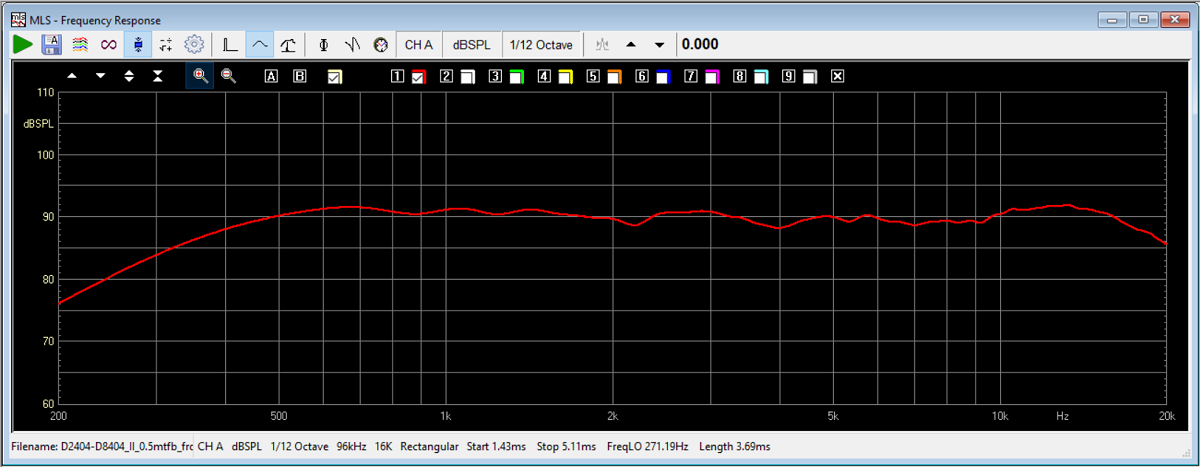
I looks smooth - and it sounds smooth. Well, really not the place here for showing measurements, but these initial readings are crucial for getting ideas of what we can achieve from a selection of drivers. As always, measurements and simulations tell us what may be possible, but only practical experiments tell us what has any future.
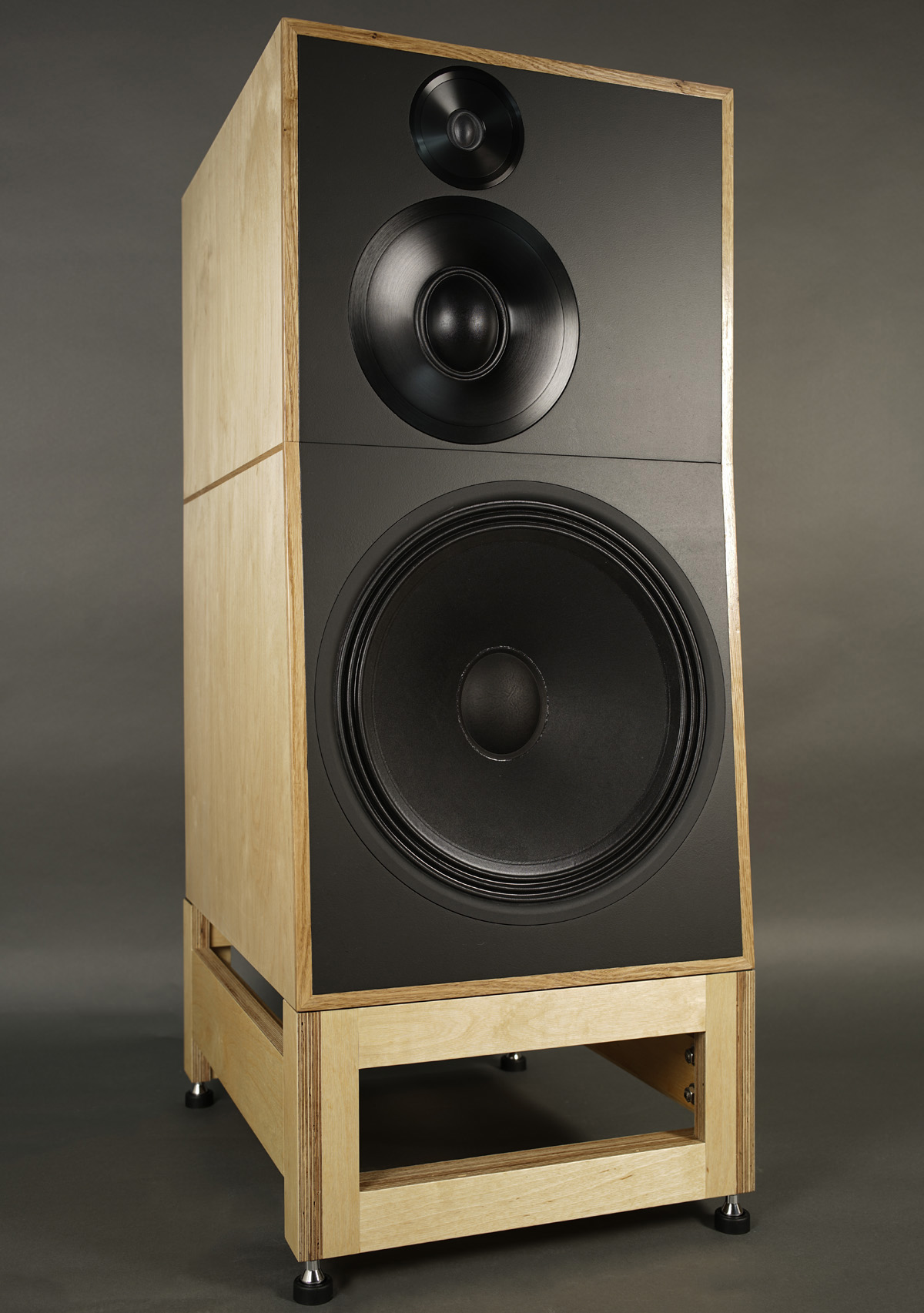
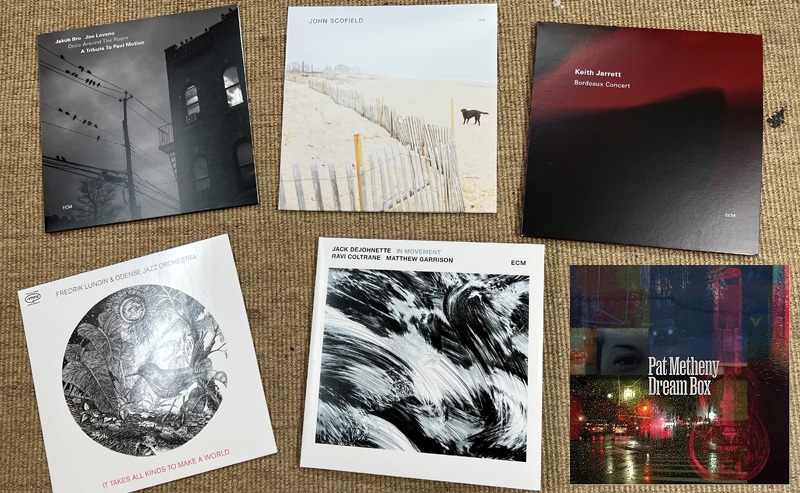
Above a recent selection of albums, which were used during testing - together with more well known albums. Insert is the Dream Box by Pat Metheny as I recently was fortunate to attend his Side Eye tour here in town. What a concert, more than 2½ hours with new music and old themes pupping up in new dress. When I walked home from the concert, I felt privileged to have been able to follow PM since around 1980, where a friend pointed to an album: Bright Size Life. It changed my musical path forever.
Funny thing: Recently I had a mail suggesting that when I write very
little on sound on an actual speaker, the writer would interpret this as
having reservations on the sound. He also noted that on one occasion I drank
an expresso and on another occasion whisky - and took that as a sign of
preference. I can ensure you that there is no
correlation between my writing - or drinking - and how much I enjoy an actual speaker.
None whatsoever! I always drink expresso in the
morning and maybe whisky late night.
But there shall be no doubt that I like this speaker very, very - very much!
And I assume you have already read this page carefully:
http://www.troelsgravesen.dk/choices.htm
And if you really wanna know: Extremely dynamic bass, smooth and
transparent midrange and treble. You can put any state-of-the-art
equipment in front of these speakers, and they will deliver the goodies
- assuming good recordings.
So, there you have it!
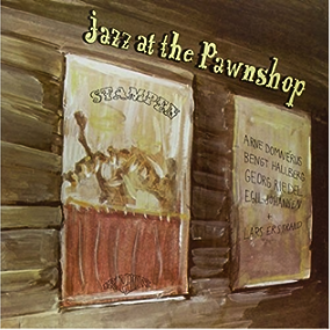
Stop press: Some 8-10 years ago I used the Jazz at the Pawnshop
extensively for testing my final speakers/crossovers and I really hadn't
use it much since then, maybe even several years since I heard it last.
I'm Confessing was one of my favourite tracks and when I came to
the clarinet solo I had to stop, make me an expresso, and go back again.
I really never heard the solo this way, free of some edginess that had
always been a signature of this particular instrument. Smooth on the ear
as never before. Well, my gear is better than it was 10 years ago, so
that may be count for some, but I guess the wide coverage of the D84 is
the main responsible. I found my other copies of the Pawnshop, I have an
original pressing back from the 80'ies - same thing. Smooth as never
before. Which, by the way, tells us that auditory memory may leave a lot
to be desired, but some apparently stays put and will never be forgotten
like some tastes and flavours.
I went to hear the same track on my A50 speakers - same thing. To some
extent they share the same crossover topology between D84 and D24, so
not a big surprise. This D84 does its thing when treated properly from
your front gear.
Basics:
3-driver speaker.
Dimensions: 42 x 50/54 x 80 cm, WxDxH.
System sensitivity: 92 dB/2.8V/1 meter.
Impedance: 4-8 Ohms.
Power requirement: 30+ watts/channel.
Useful links (Please
follow all links before e-mailing!):
http://www.troelsgravesen.dk/tips.htm
http://www.troelsgravesen.dk/tips.htm#CONSTRUCTION_OF_CROSSOVERS
http://www.troelsgravesen.dk/crossovers.htm
http://www.troelsgravesen.dk/LCR-RC.htm
http://www.troelsgravesen.dk/Inverted-Polarity.htm
http://www.troelsgravesen.dk/choices.htm
http://www.troelsgravesen.dk/power-handling.htm
Click images to view large
Download specs here: D2404/552000 D8404/552000 38WE/8582T00
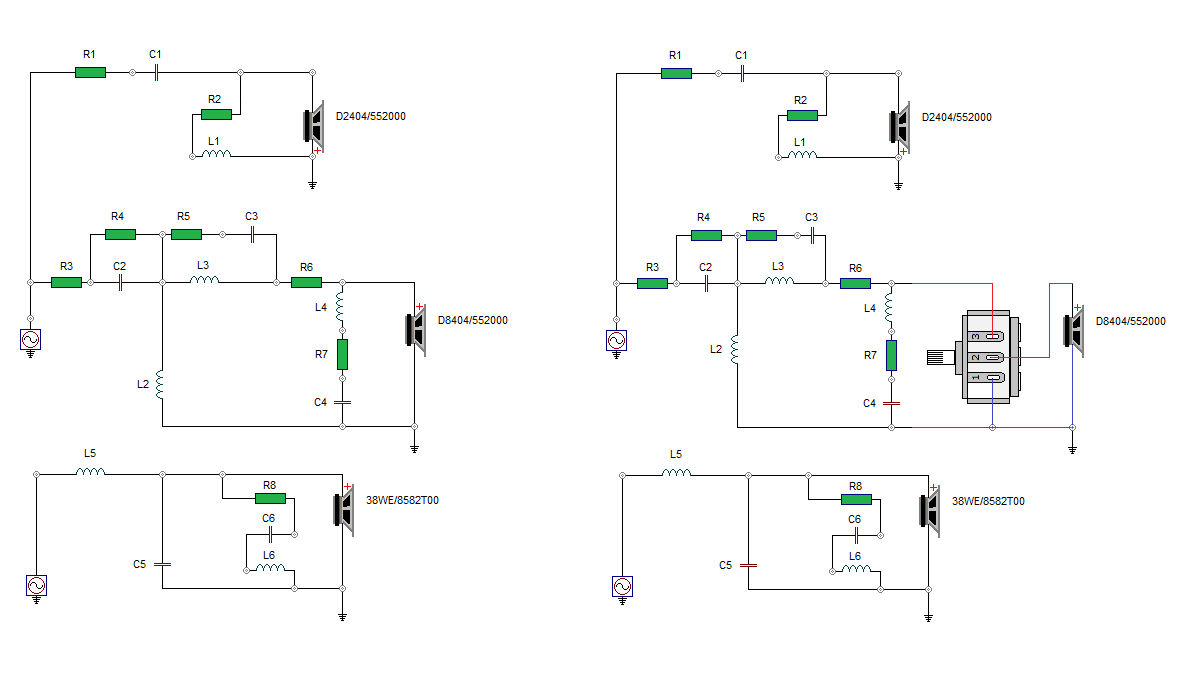
If you want to have an attenuator on the D84 dome, add the
Fostex R80B. Using the attenuator, we change R6 to a lower value and
attenuator must be at -1 dB to make the same level.
Cabinet with tilt of bass baffle. Obviously you don't need two ports, but you can place it to the rear -
or bottom. Wherever I place the port, there will always be a guy who
wants it different!
Now, you can make the cabinets classic with a vertical front panel to
easy construction, but having the 38WE working up into the lower
midrange the bass baffle tilt does good for the overall projection of
sound.
I used 25 mm HDF for the front panels.
Cut the supplied 100 mm tube to two pcs of 90 mm for the port.
Flat-pack cabinets available from
EBEL Holztechnik, Germany:
https://www.ebelholztechnik.de/galerien/index.php/category/430-ellipticor_84
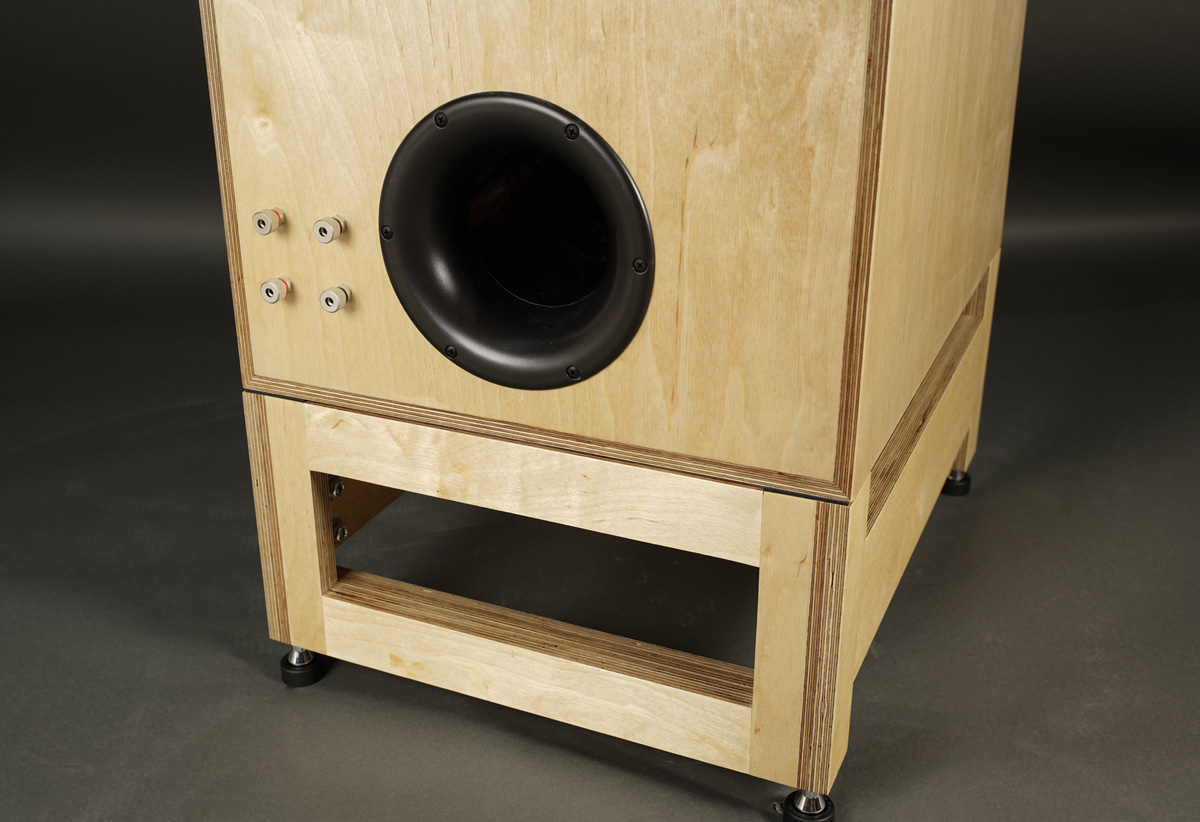
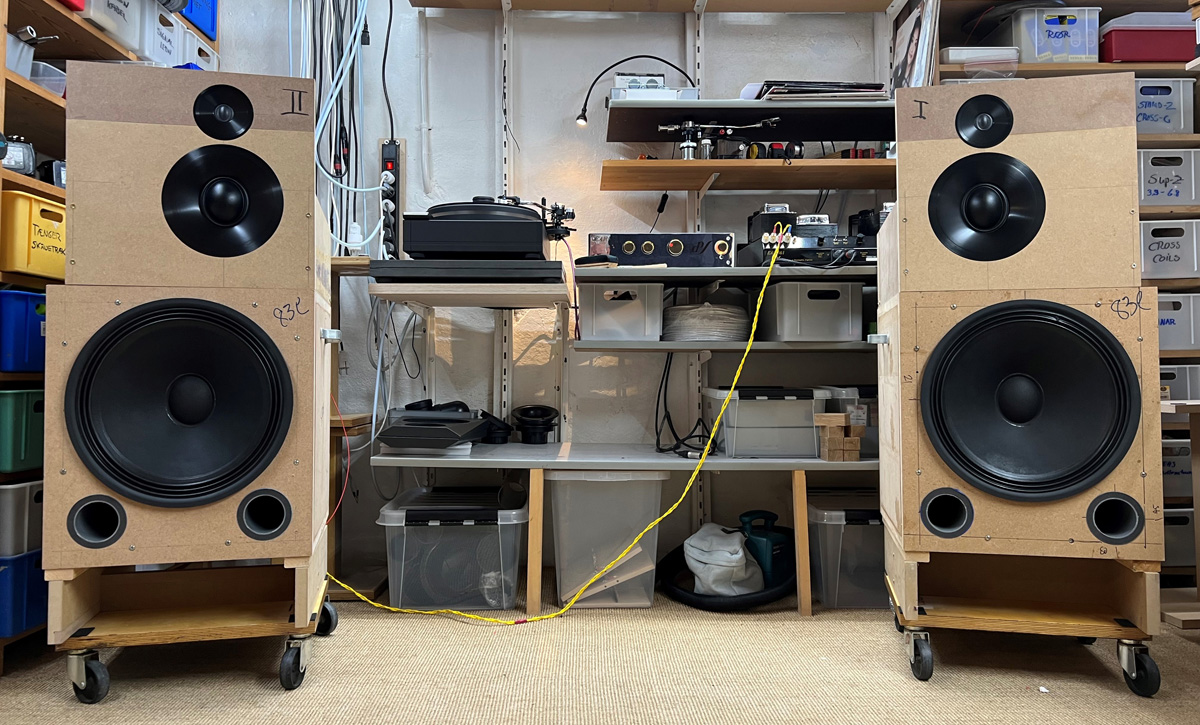
Everything starts with a mockup!
I have some 83 litre cabs for testing 15" drivers. That doesn't make the
bass go as deep as can be, but they are more than suitable for a start
to hear if this thing has any future at all.
The preliminary crossover was rather complicated - as often is in the
beginning. Then the process of simplification starts. What can be made
smarter, what can be left out and still deliver. Many times you go to
bed thinking this is it, but after a good night's sleep you get new
ideas to how things can be done. You hear more records and discover
things that might sound better and you do modifications and adjust
mid-dome and tweeter levels.
What struck me first was how deep, potent and dynamic bass this
construction delivers driven from "only" 32 watts from my EAR-861. No
bi-amping, just 32 tube watts. My goodness this amp can rock these
light-weight 15" bass drivers. The 91-92 dB system sensitivity does its
thing. The Kuzma, MSL cartridge, the EAR-868, the EAR-861 - and then
this Ellipticor-84... This, for sure, would satisfy most listeners, I'm
sure. OK, not a cheap system, I admit. EAR prices have skyrocketed over
the last couple of years. I was lucky a few years back to purchase the
2nd hand -861 for less than 3k€.
Next thing that surprises - again - is the mid-dome's ability to play
loud without distortion. Saxophone, violins, electric guitars, etc.
Everything clean and loud till your ears bleed.
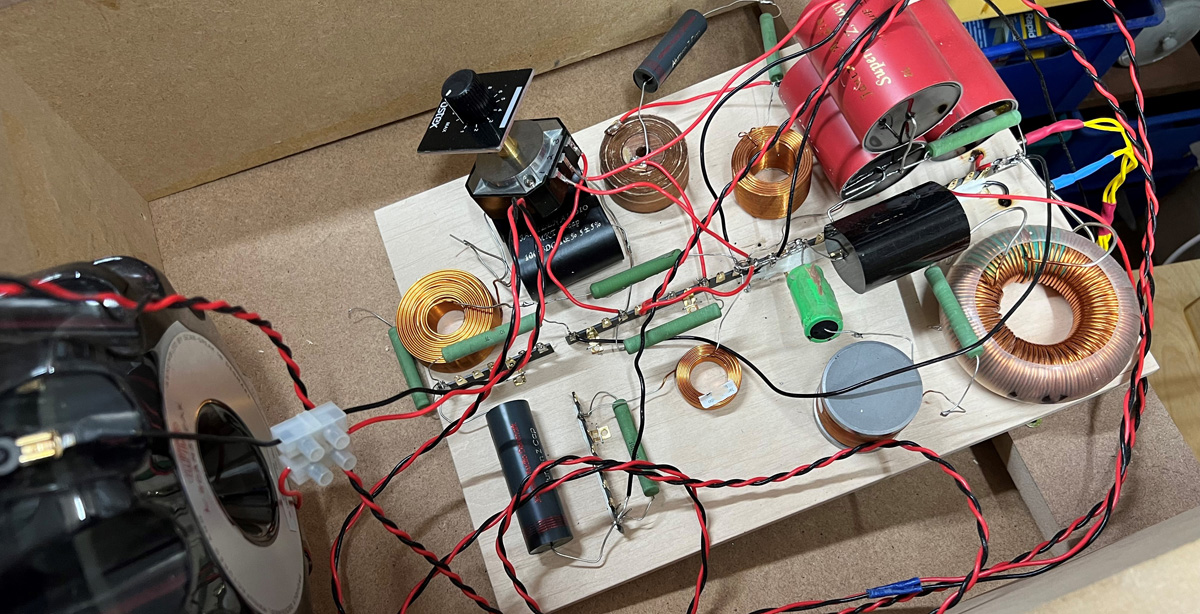
Test crossover.
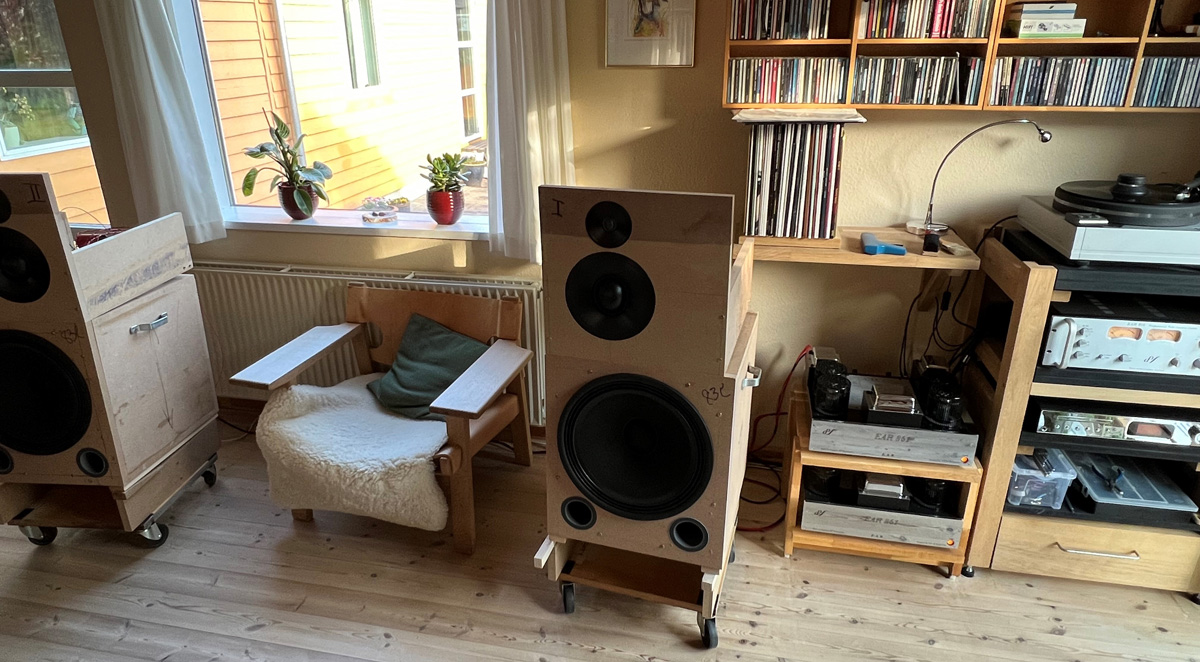
To my wife's horror, testing my mockups in our living room!
No, she
didn't freak out! Bless her tolerant soul.
The speakers certainly didn't do less here, driven from my bridged
EAR-861s. Wauw!
After that no doubt in my mind - go to the workshop to cut panels.
Making the final cabinets:
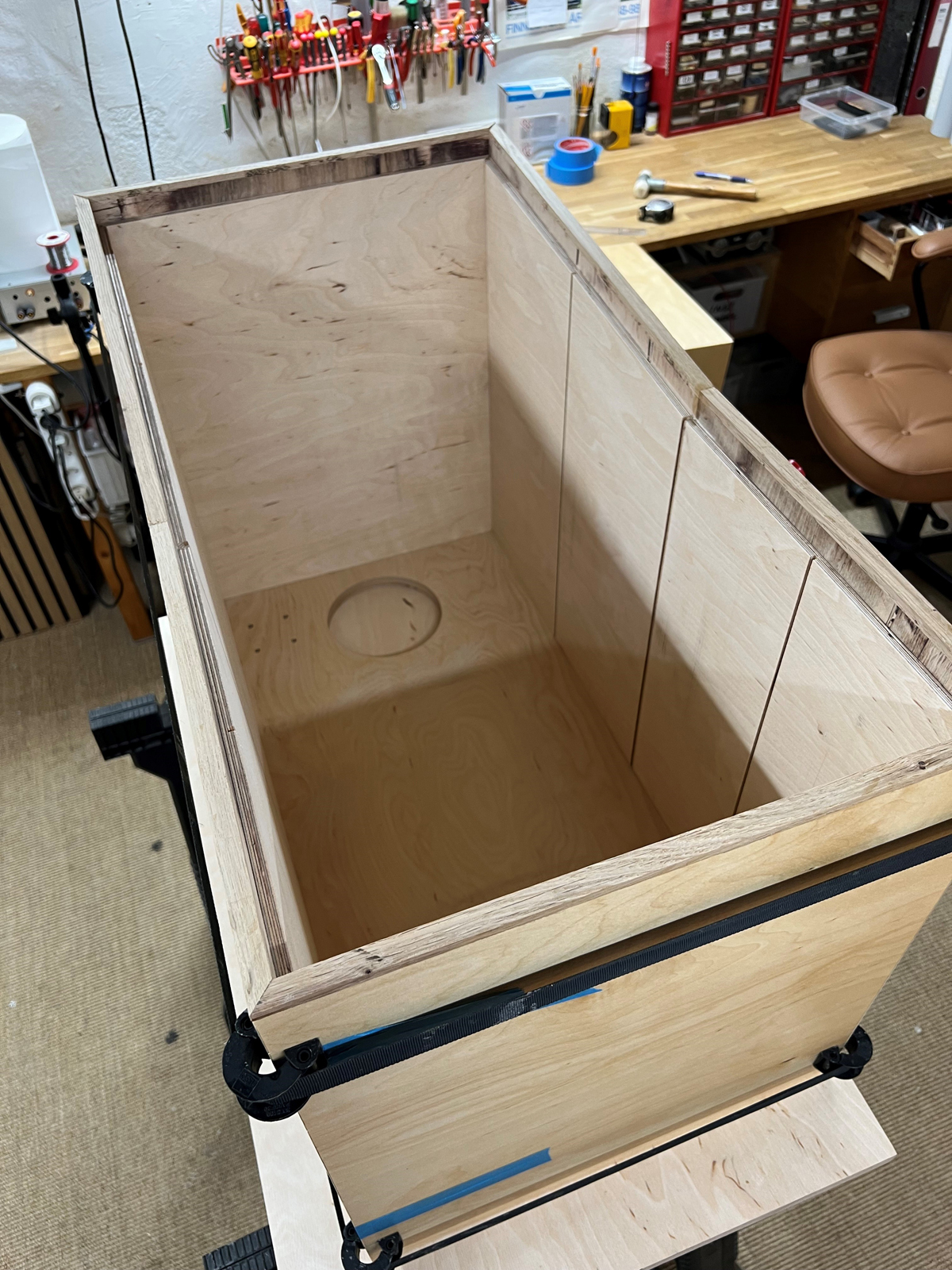
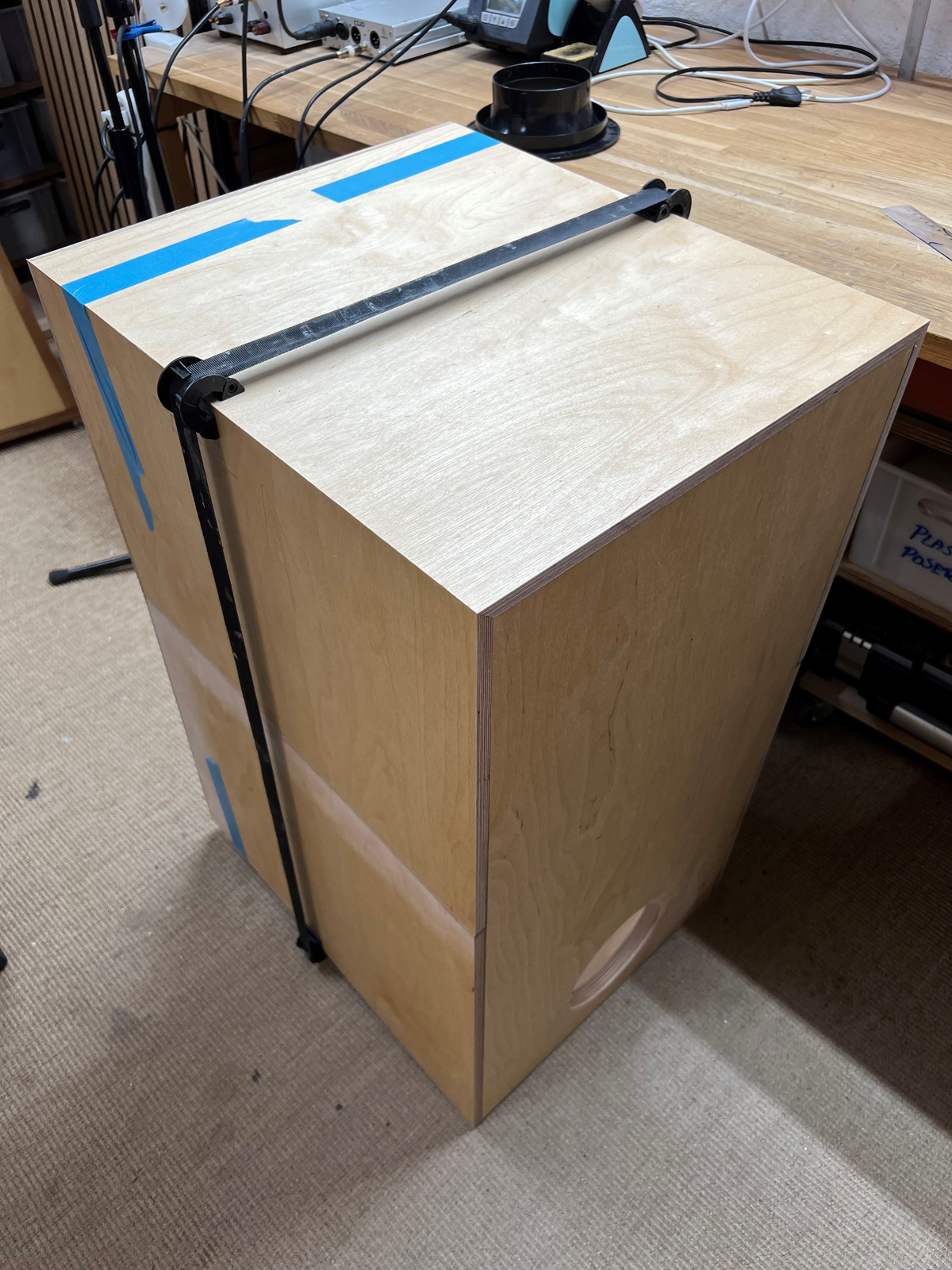
Making 125+ liter cabinets is a bit more complicated than a 20 liter
standmount!
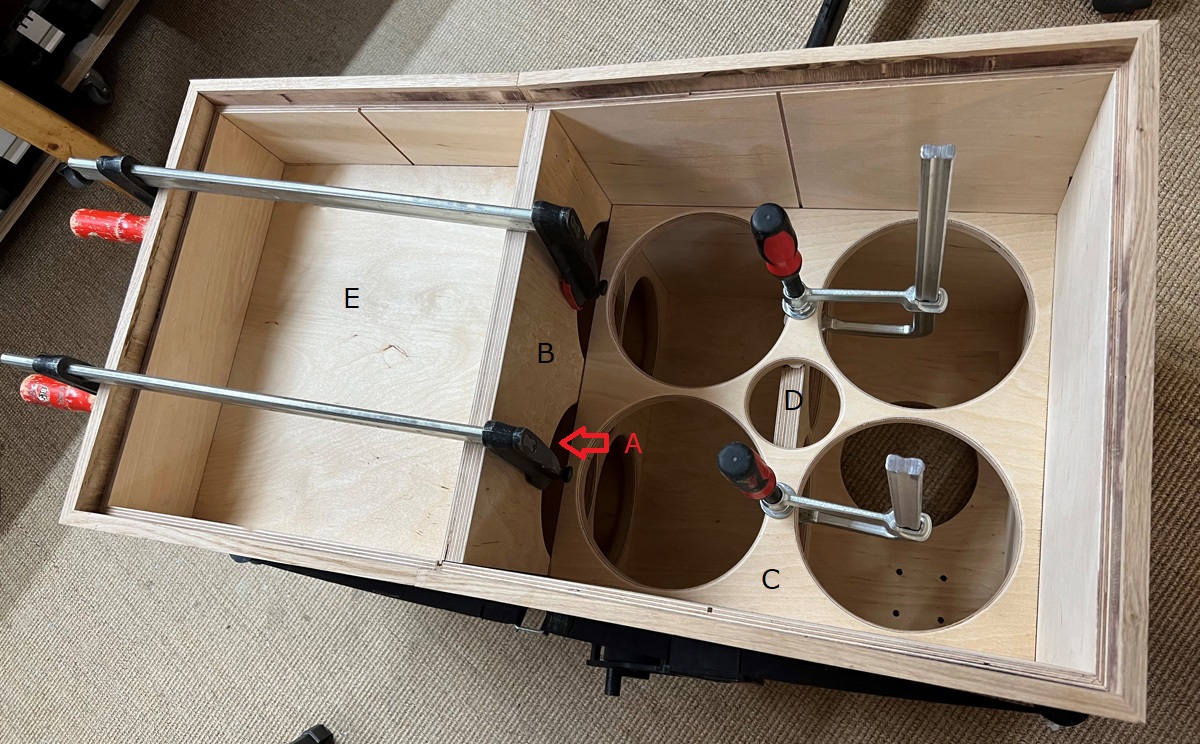
All braces done and have started gluing.
Before gluing the cabinet sides and rear I first glued panel E and B.
That done I glued panel A to E+B making a structure that can slide in
and out if the cabinet.
Next I glued panels C and D, also able to slide in and out of cabinet.
These two structures make a good scaffold for assembly of the entire
cabinet.
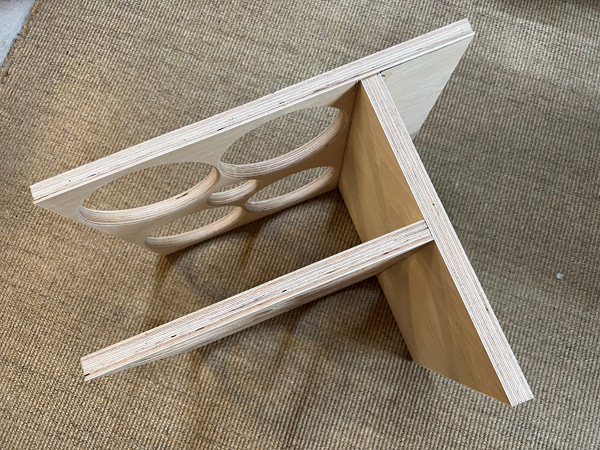
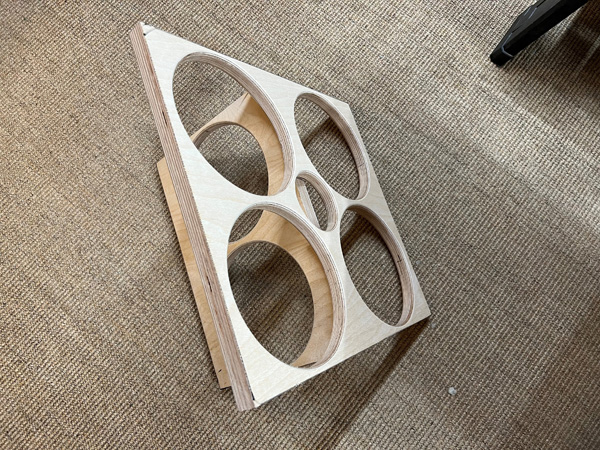
Left: A+E+B. Right: D+C.
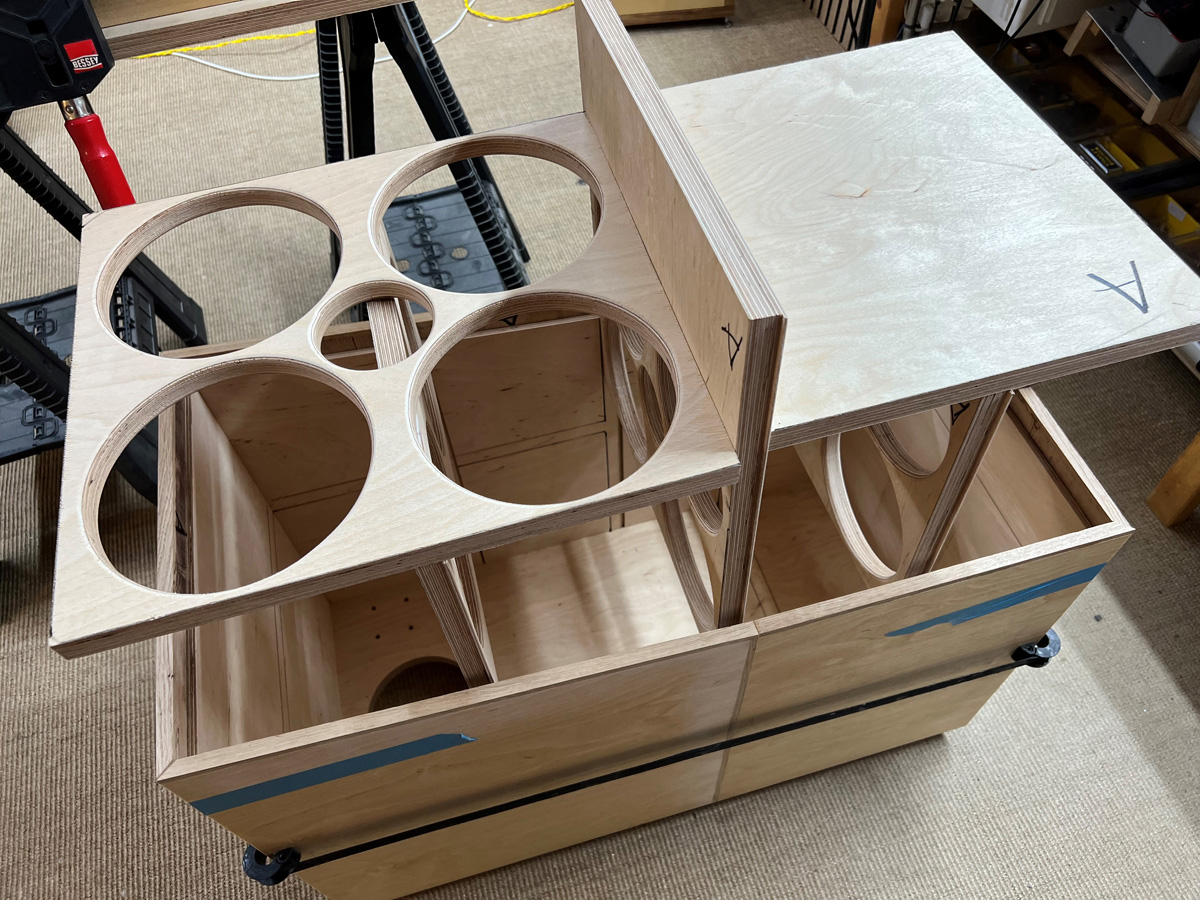
Structures lifted from cabinet.
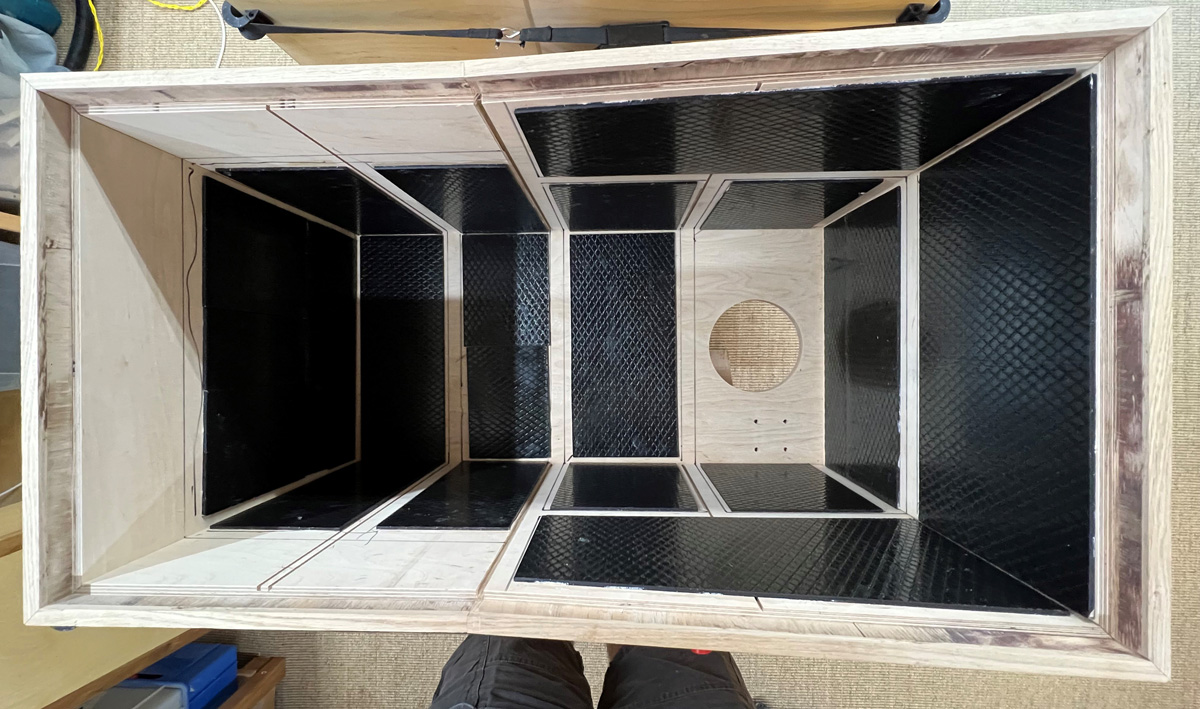
Above the bitumen pads in place. Midrange cabinet and upper braces can
still slide into the cabinet.
Bottom braces must be added during final cabinet assembly.
Remember bitumen pads do not have to cover the entire surface of panels.
5-10 mm to all nearby structures is fine. 2 sqm provided with kit if you
want to use this.
http://www.troelsgravesen.dk/tips.htm#Glue_for_Bitumen_Pads
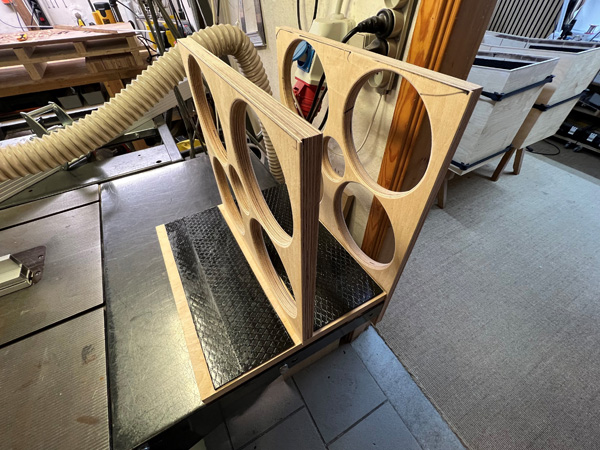
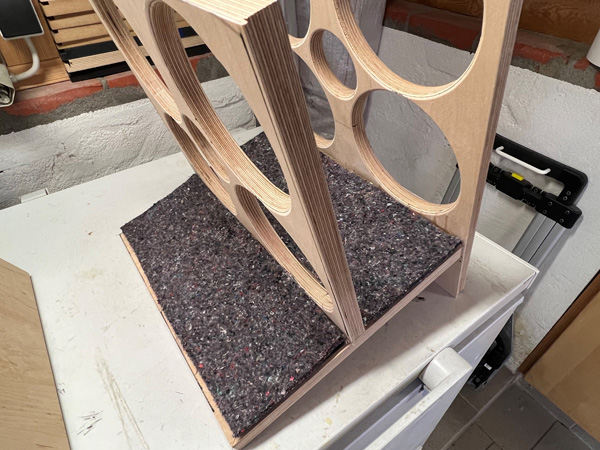
Top structure added bitumen pads on rear side of midrange back panel.
Right: With felt.
No bitumen pads inside midrange cabinet.
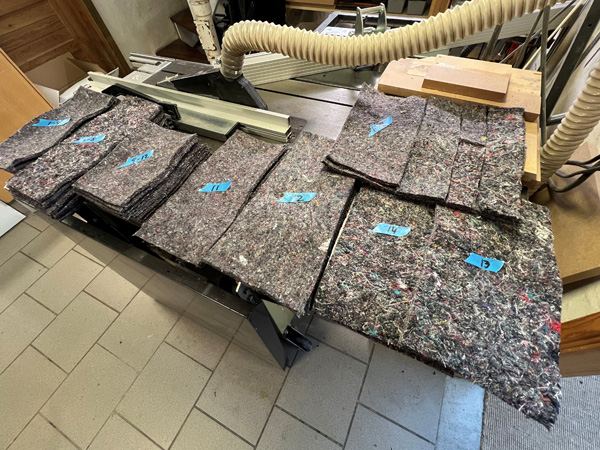
Cut all felt sheets and mark them carefully for placement.
And felt cuts do not have to be in single pieces. To utilise the felt
properly a patchwork is fine.
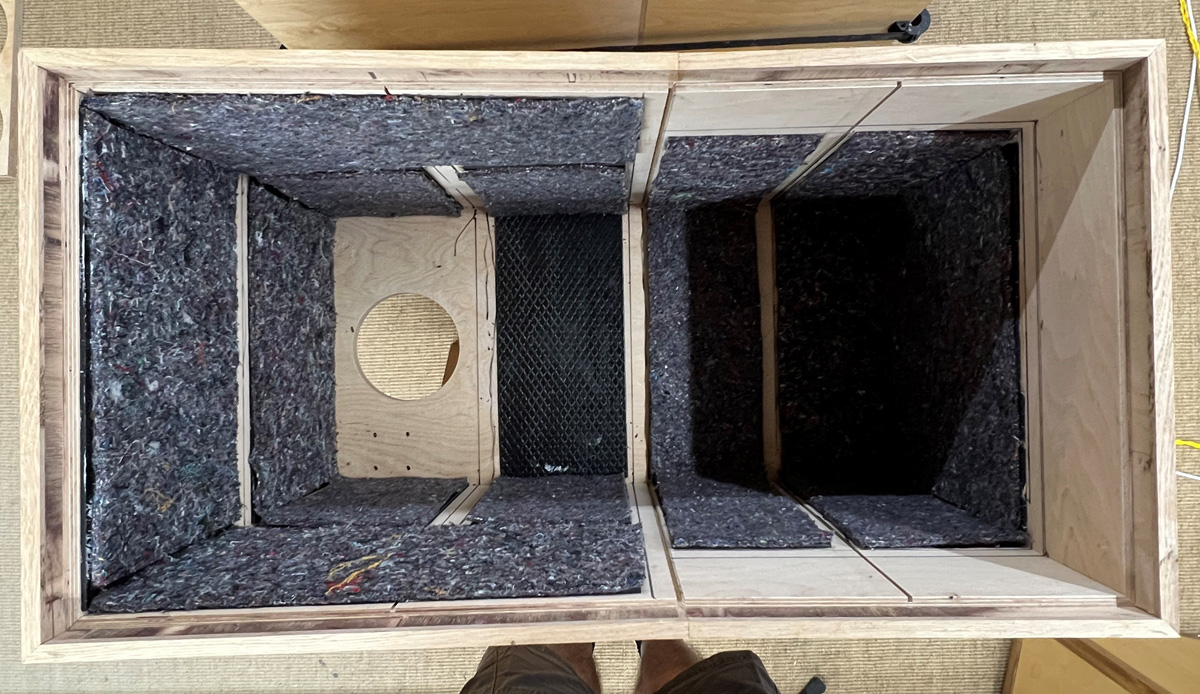
All felt sheets applied.
No felt on rear panel above port hole, where the mid crossover will be.
At the bottom next to the port hole, leave some panel, like 6 cm, blank
to give room for the bass crossover. There is just about space for the
crossover. See at bottom of page.
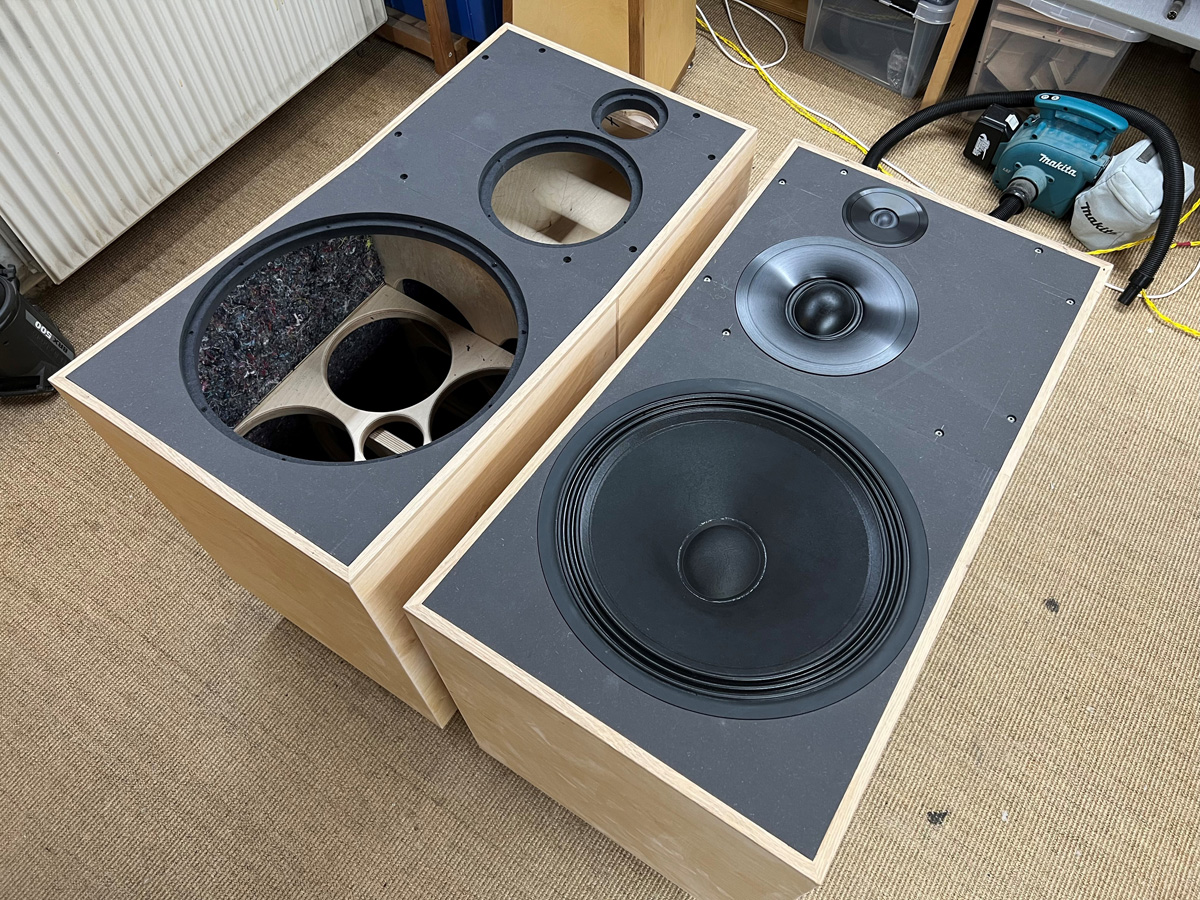
Cabinets ready for lacquer and paint.
Acoustilux:
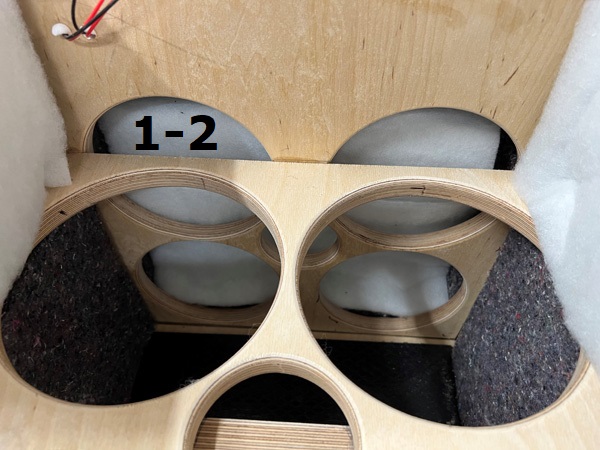
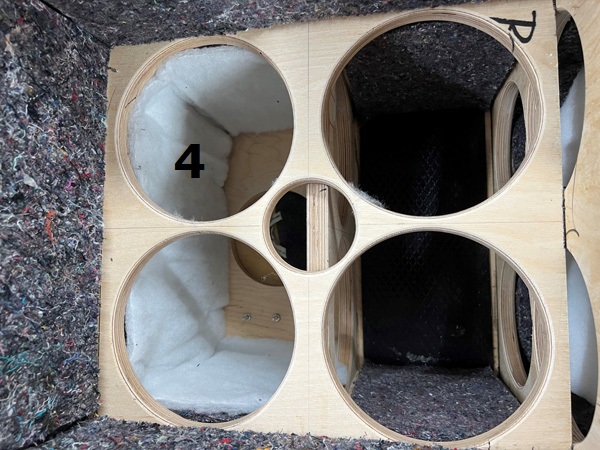
Left: Upper compartment 1-2. Right: Compartment 4.
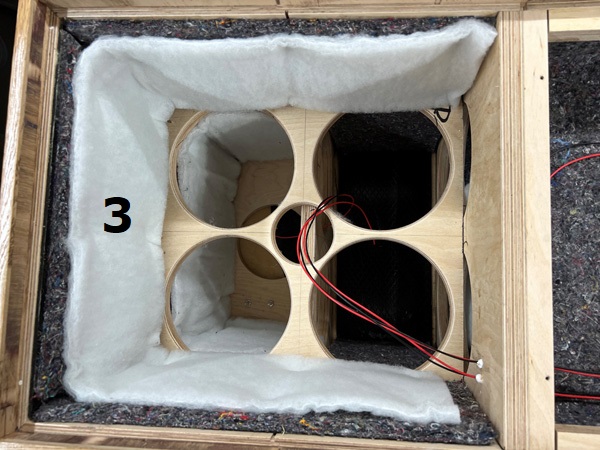
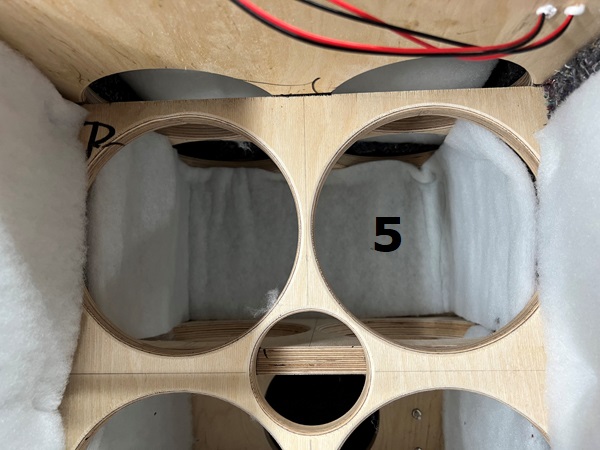
Left: Compartment 3. Right: Compartment 5.
Acoustilux:
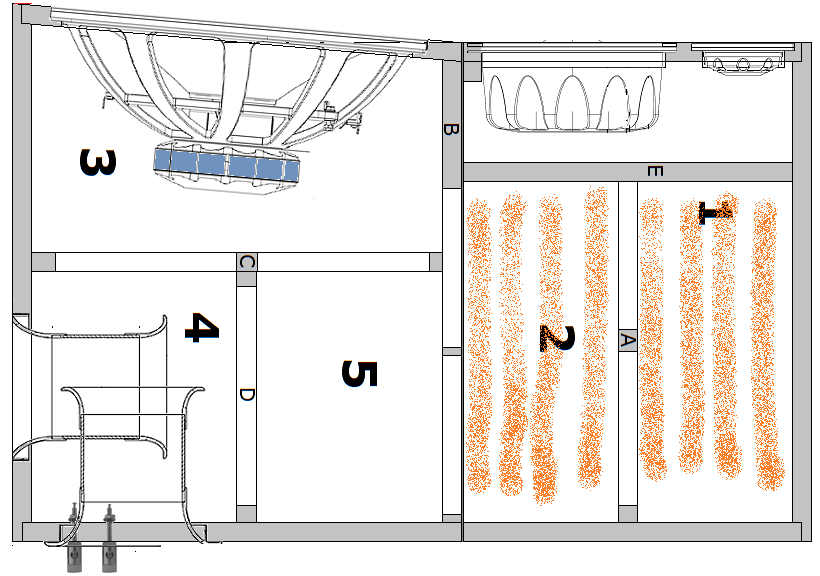
Cuts for two cabinets:
1-2: Cut 8 pcs 35 x 50 cm and fold two like this:
 - and place
in compartment 1 and 2.
- and place
in compartment 1 and 2.
Don't fasten, just let the "pillows" rest on braces.
3: Cut 2 pcs 18 x 112 cm and add to sides and bottom of compartment 3. See images above.
4: Cut 2 pcs of 25 x 75 cm and place on sides and bottom of compartment 4.
5: Cut 2 pcs of 19 x 83 cm and place on sides and rear panel of
compartment 5. This covers the crossovers for mid and tweeter.
All in all around 550 cm x 50 cm = 2.75 sqm. 3.0 sqm supplied in kit.

Mounting Ellipticor drivers:
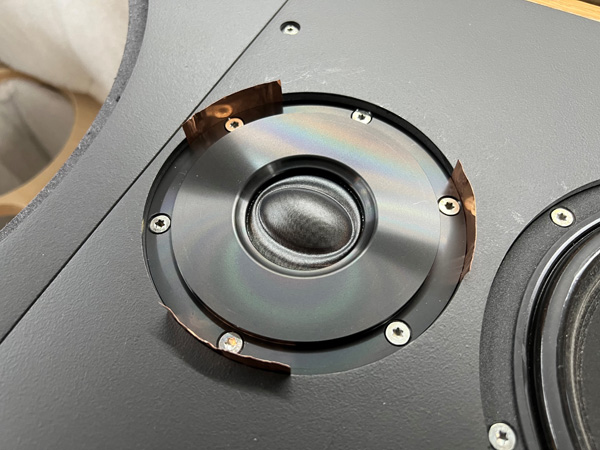
Using countersunk screws will eventually skew
the drivers a tiny bit and if you have to press the decor ring into
place - you are never going to get it up again!
So, add some foil around the driver when fastening the screws. This way
you will leave some 0.1-0.2 mm space between decor ring and cabinet.
Removing the decor ring by rotating until it slips the magnets and lift
with another small neo magnet. The tweeter decor ring pops up by itself.
The D84 doesn't.
When routing for the D24 and D84, make the rebate diameter +0.5 mm. See
Ellipticor-A50-mkII for more pics.
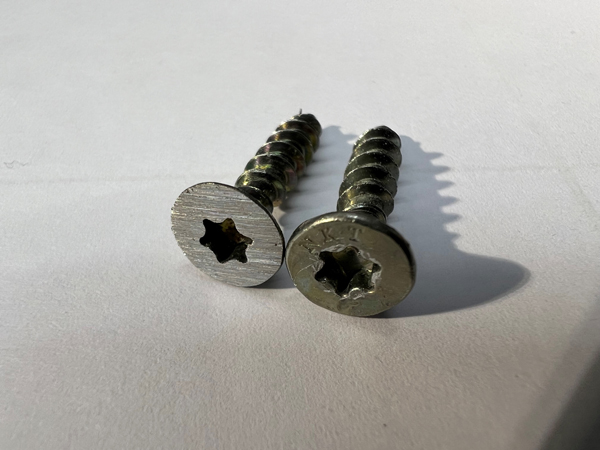
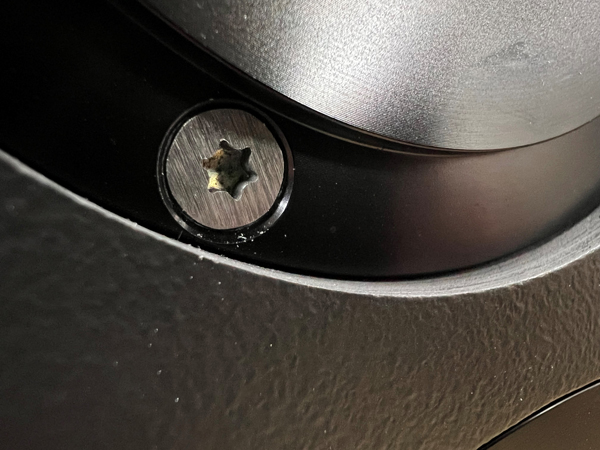
The screws for the tweeter need to be well countersunk. I found some
good torx 20, 4 x 20 mm screws at the local Bauhaus and for the tweeter
I did some grinding to reduce the head size and to make sure the decor
ring doesn't ride the edge of any screws and cause buzzing. This is
important.
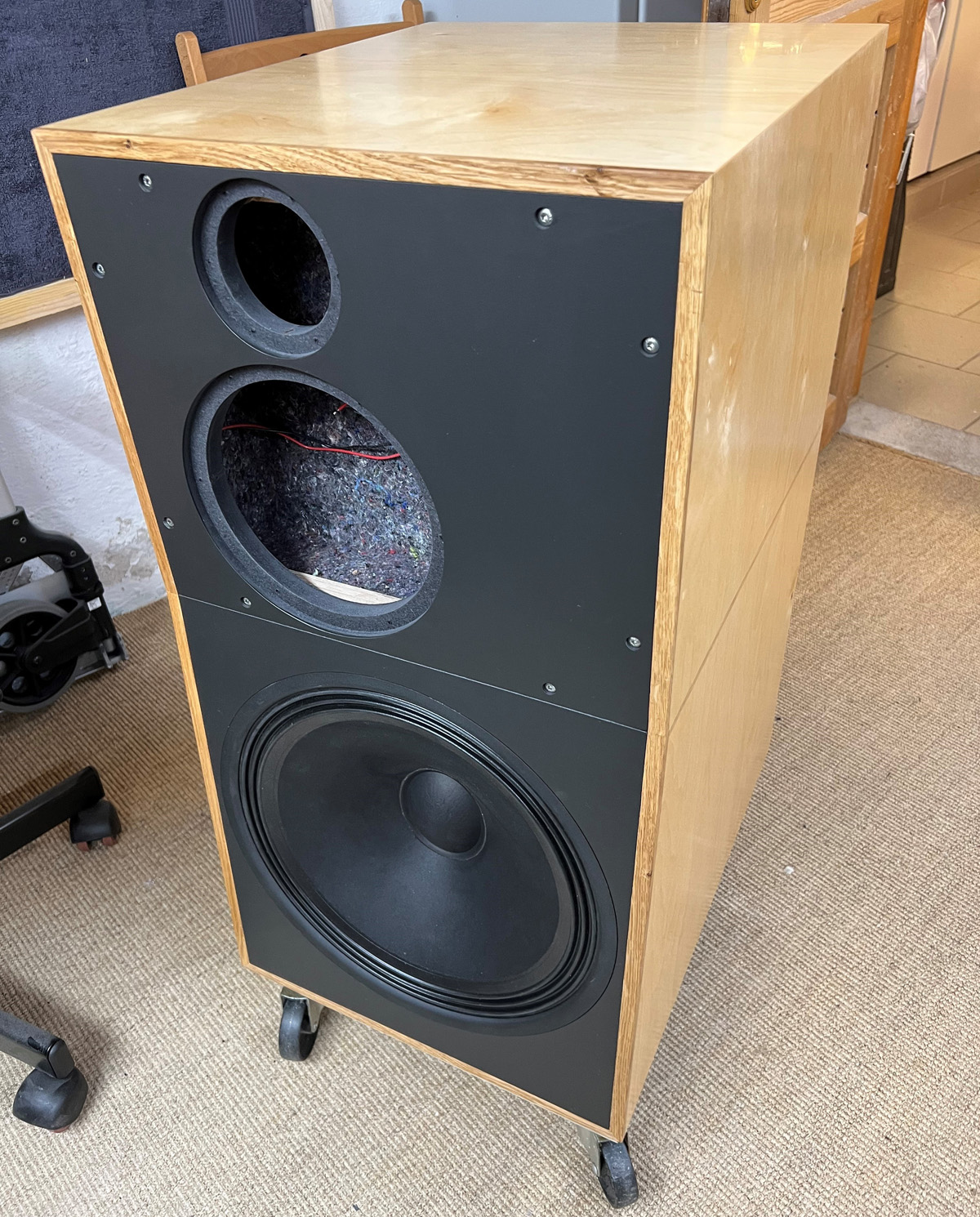
So, cabinets waiting for the crossover parts from Jantzen Audio.
In the meantime I'll start making the stands. See
below ->
A few comments on
MEASUREMENTS before you start interpreting the readings below.
First of all, if we think measurements will
tell us how a speaker sounds, we're wrong. The perception of sound is
way too subjective to be reflected in any measurements we can perform. A
loudspeaker system is meant to give us a satisfying idea of an acoustic
event and for some people a pair of 5 USD ear-plugs are enough, others
spend 200 kUSD on a truly full-range pair of speakers - and the latter
may not be happier than the former.
Measurements may give us an idea of tonal balance of a system, i.e. too
much or too little energy in certain areas, although dispersion
characteristics play a vital role here. A two-way 7+1 and a three-way
7+4+1 may display similar horizontal dispersion, yet sound very
different. Measurements may tell us about bass extension if far-field
measurements are merged with near-field measurements. In addition to
this, ports may contribute to bass extension. Most of we diy'ers do not
have access to an anechoic room for full-range measurements from
20-20000 Hz.
What cannot be seen is what kind of bass performance we get in a given
room. Bass performance is highly dependent on in-room placement of your
speaker and the same speaker can be boomy in one place and lean in
another. Actual SPL level at 1 meter distance and 2.8V input is useful
for en estimate of system sensitivity and combined with the impedance
profile may give an idea of how powerful an amplifier is needed to drive
the speaker to adequate levels.
What measurements do not tell is the very sound of the speaker unless
displaying serious linear distortion. The level of transparency, the
ability to resolve micro-details, the "speed" of the bass, etc., cannot
be derived from these data. Distortion measurements rarely tell much
unless seriously bad, and most modern drivers display low distortion
within their specified operating range.
Many people put way too much into these graphs and my comments here are
only meant as warning against over-interpretation. There are more to
good sound than what can be extracted from a few graphs. Every graph
needs interpretation in terms of what it means sonically and how it
impacts our choice of mating drivers, cabinet and crossover design.
What measurements certainly do not tell is the sonic signature of the
speaker, because speaker cones made from polypropylene, aluminum,
Kevlar, paper, glass fiber, carbon fiber, magnesium, ceramics or even
diamonds all have their way of adding spices to the stew. Nor do
measurements tell what impact the quality of the crossover components
add to the sound, from state of the art components to the cheapest of
coils and caps, they all measure the same if values are correct, yet
sound very different.

SPL of midrange and tweeter.

SPL of bass driver without the crossover. Port contribution not
included.
These 38WEs go deep!

SPL of the two D84 drivers, here without crossover on actual baffle.
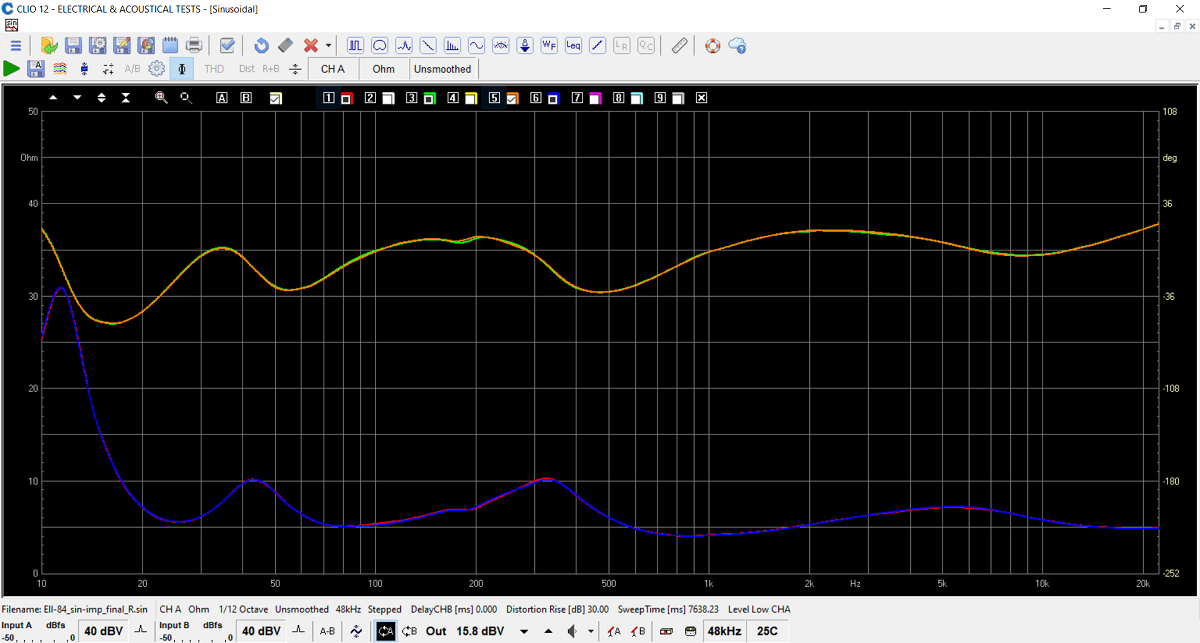
Final system impedance of both speakers - if you can distinguish the
left and right speaker!
That is an easy load - no wonder my only 32 wpc EAR-861 loves these
speakers.
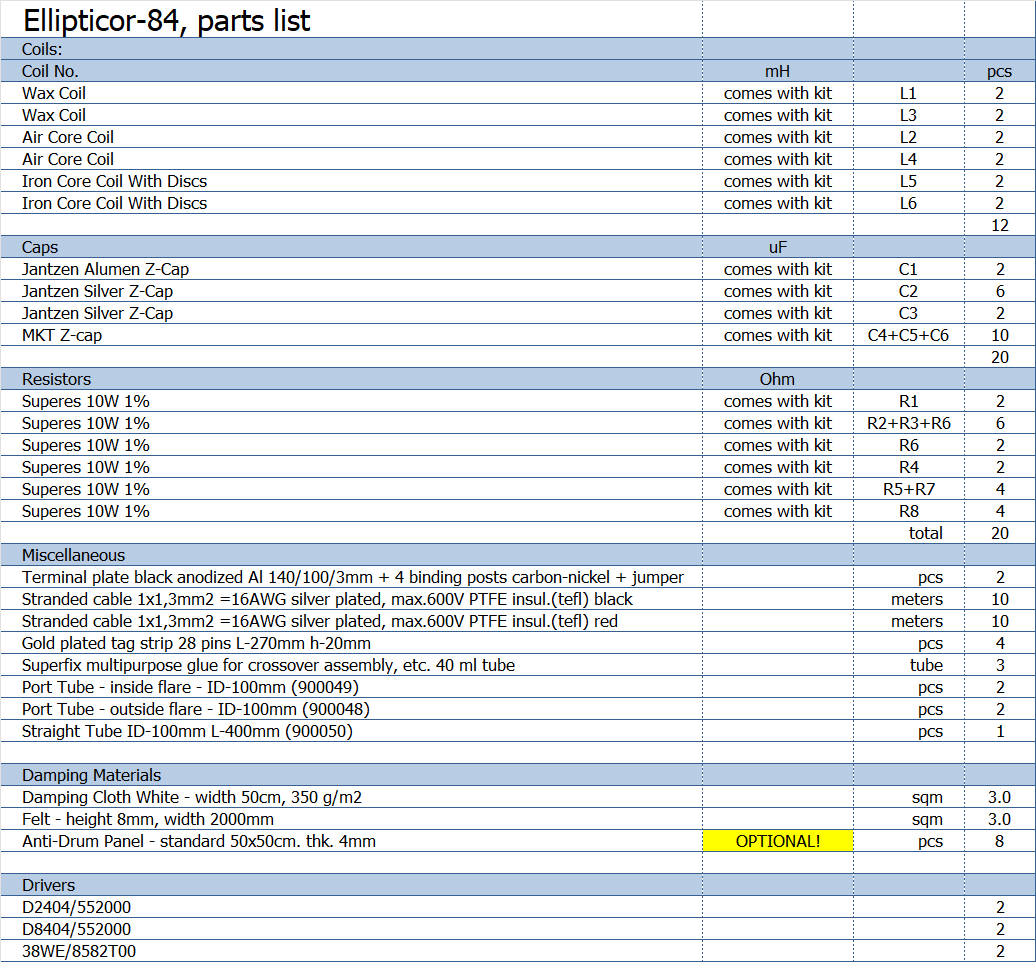
All kit and component prices may be subject to change and are always to be confirmed by Jantzen Audio Denmark.
Kits can always be bought with/without drivers, or some of the drivers.
Download Complete Kit Sale Presentations:

All technical questions to troels.gravesen@hotmail.com
All questions regarding purchase of kits, please mail Jantzen Audio at contact@jantzen-audio.com
CROSSOVER-LAYOUT
BACK TO INDEX
Check this out before start making crossovers:
http://www.troelsgravesen.dk/tips.htm#CONSTRUCTION_OF_CROSSOVERS
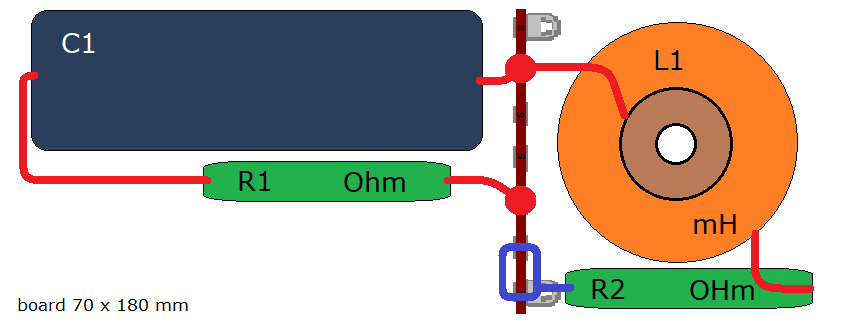
Tweeter layout.
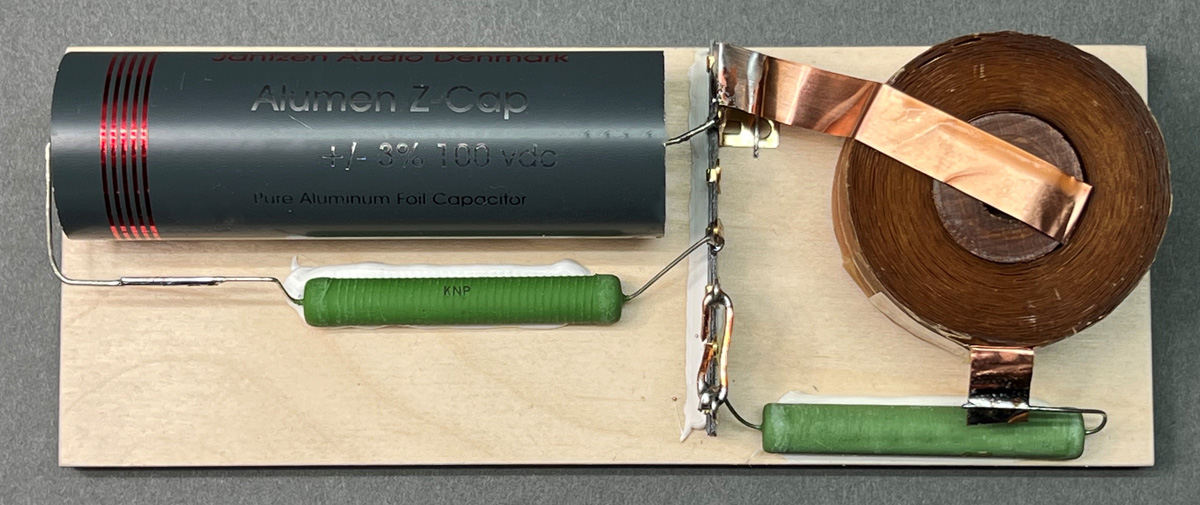
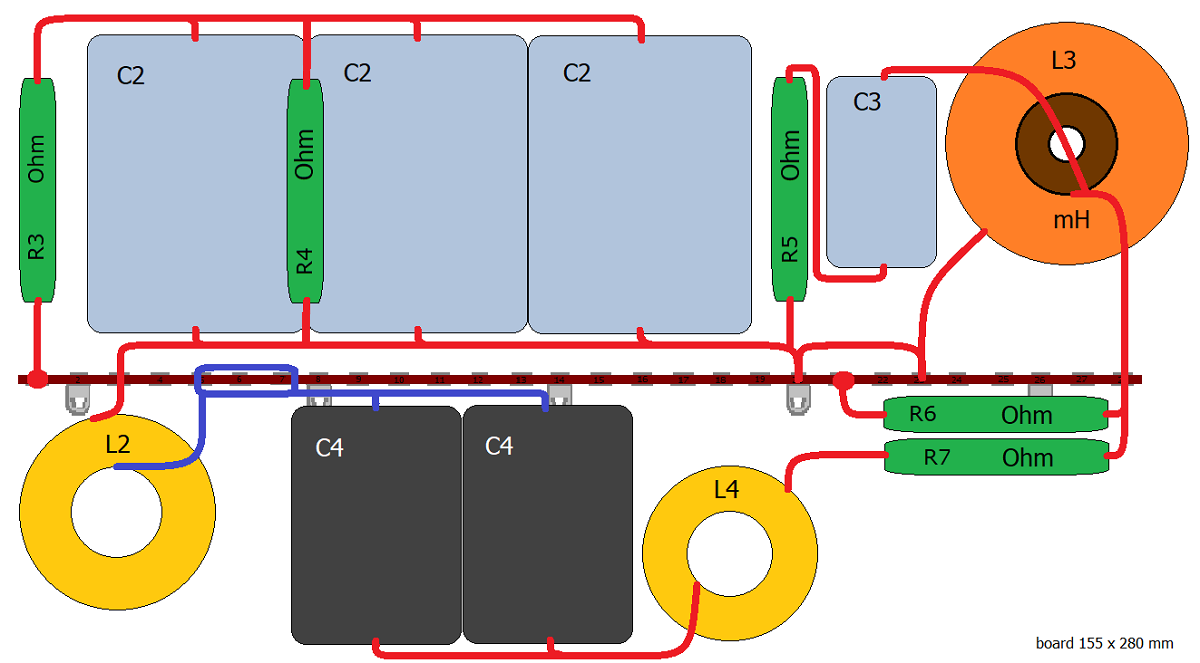
Midrange layout.
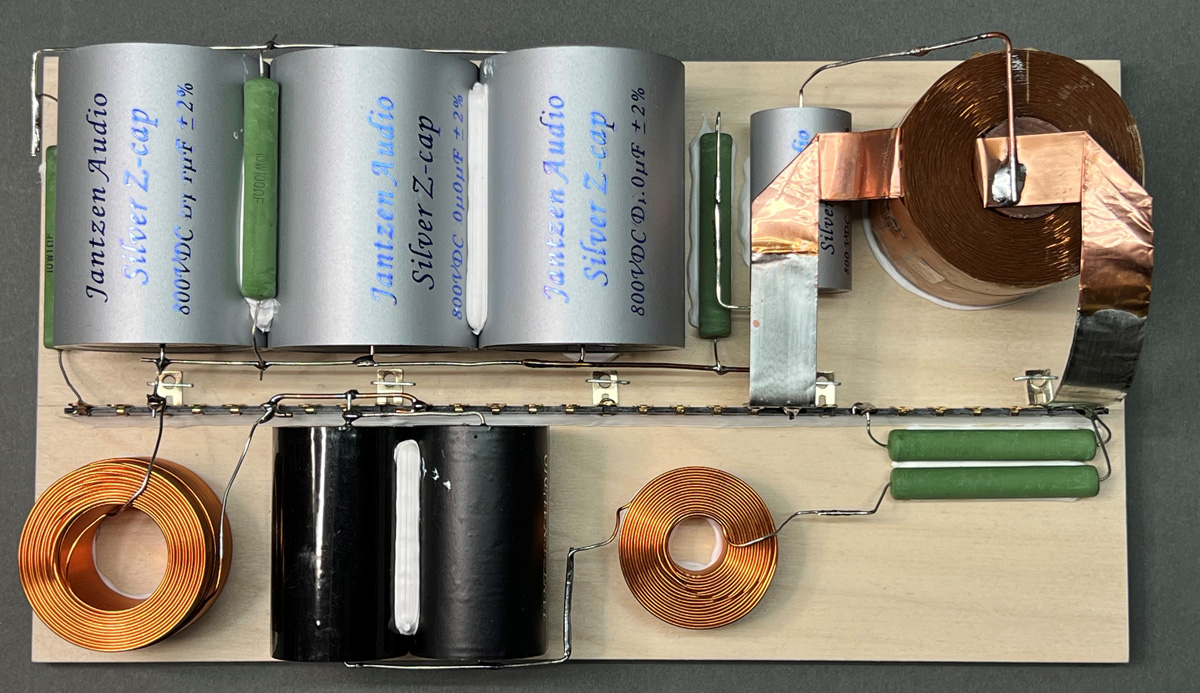
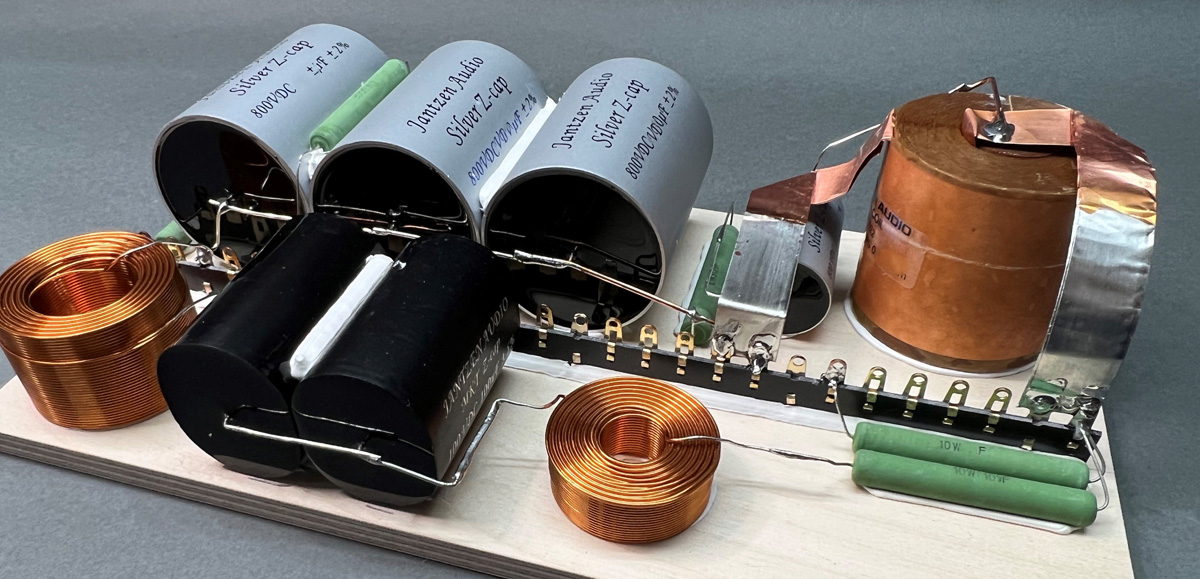
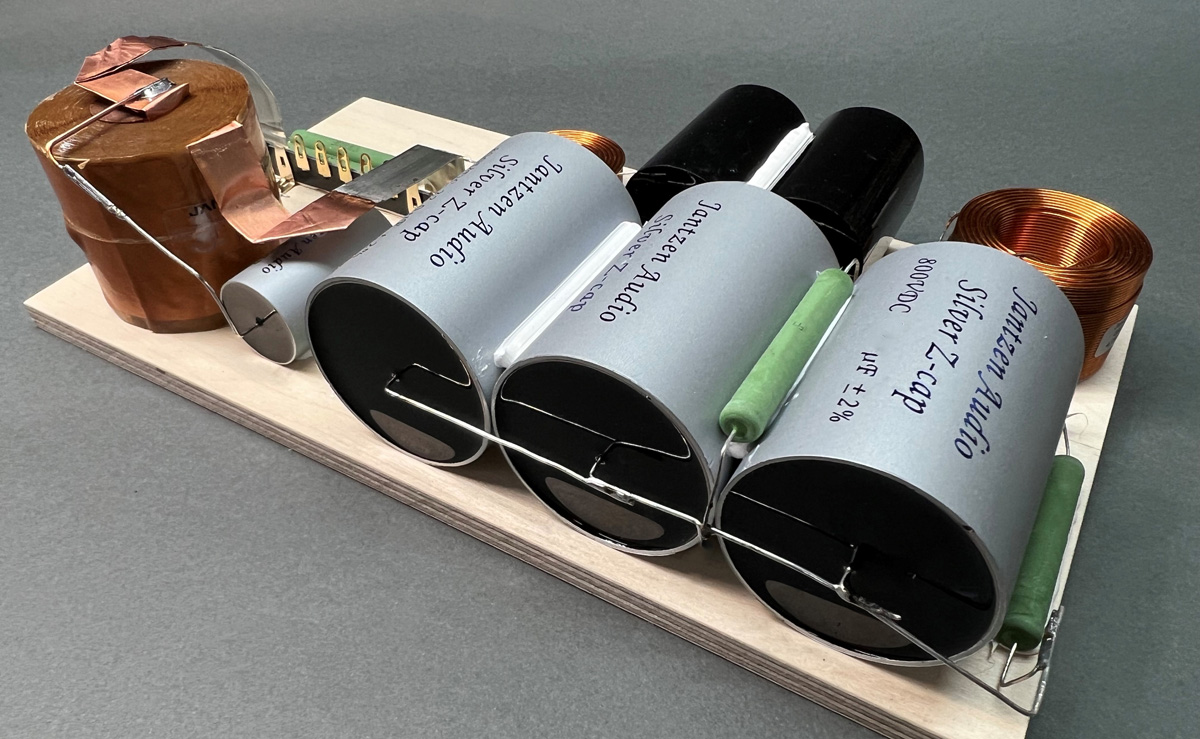
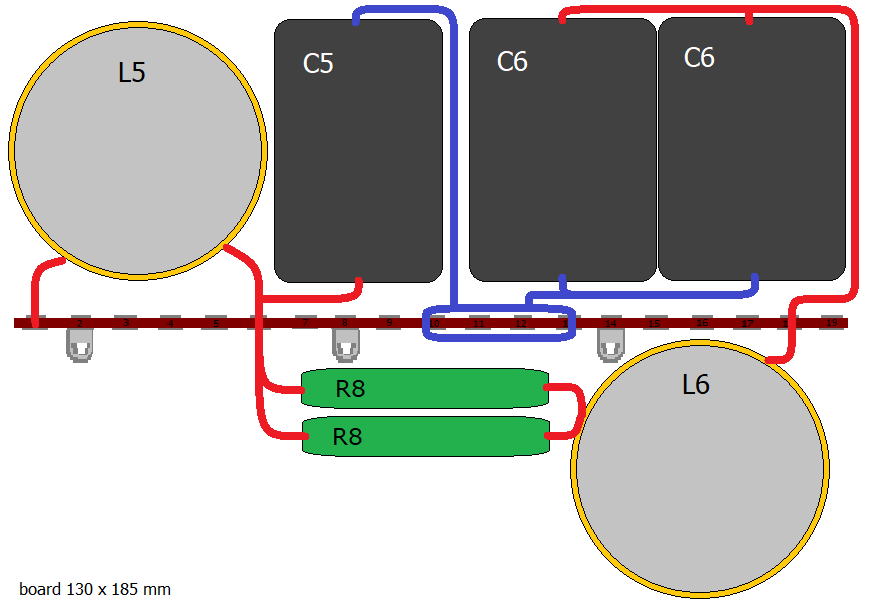
Bass layout.
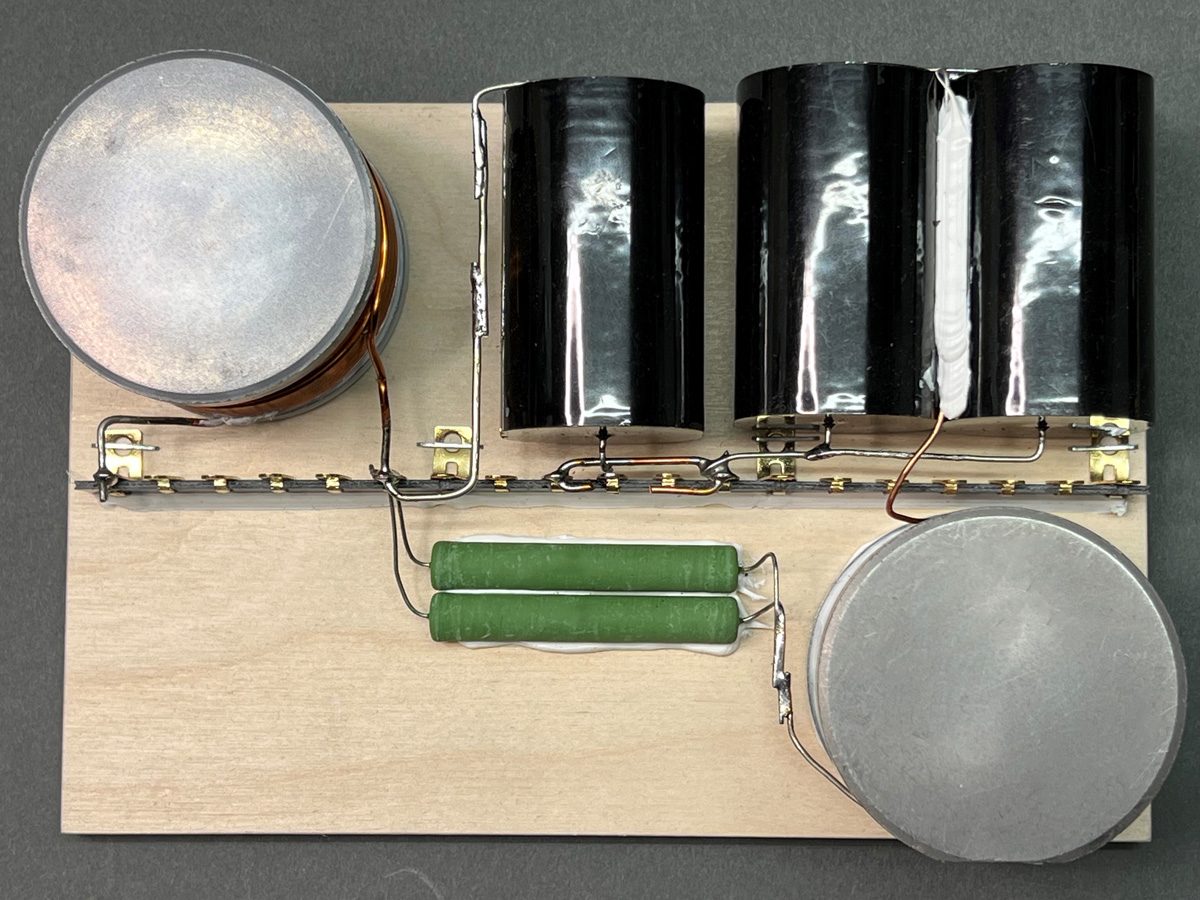
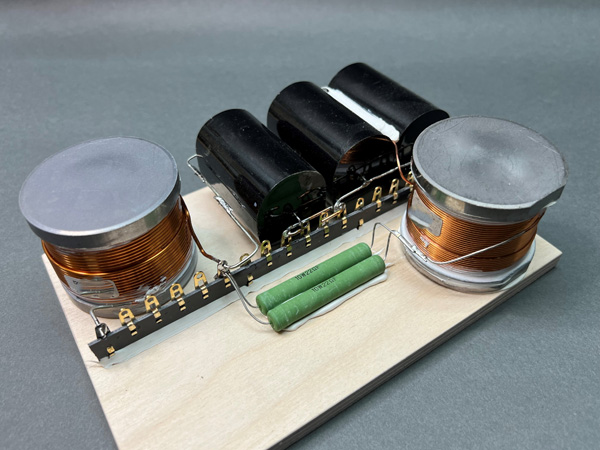
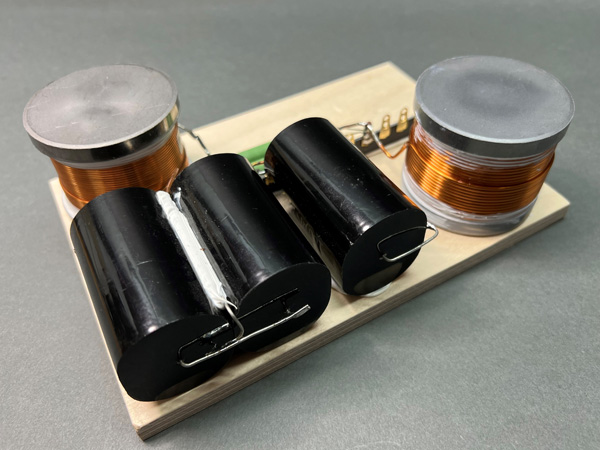
Speaker wiring:
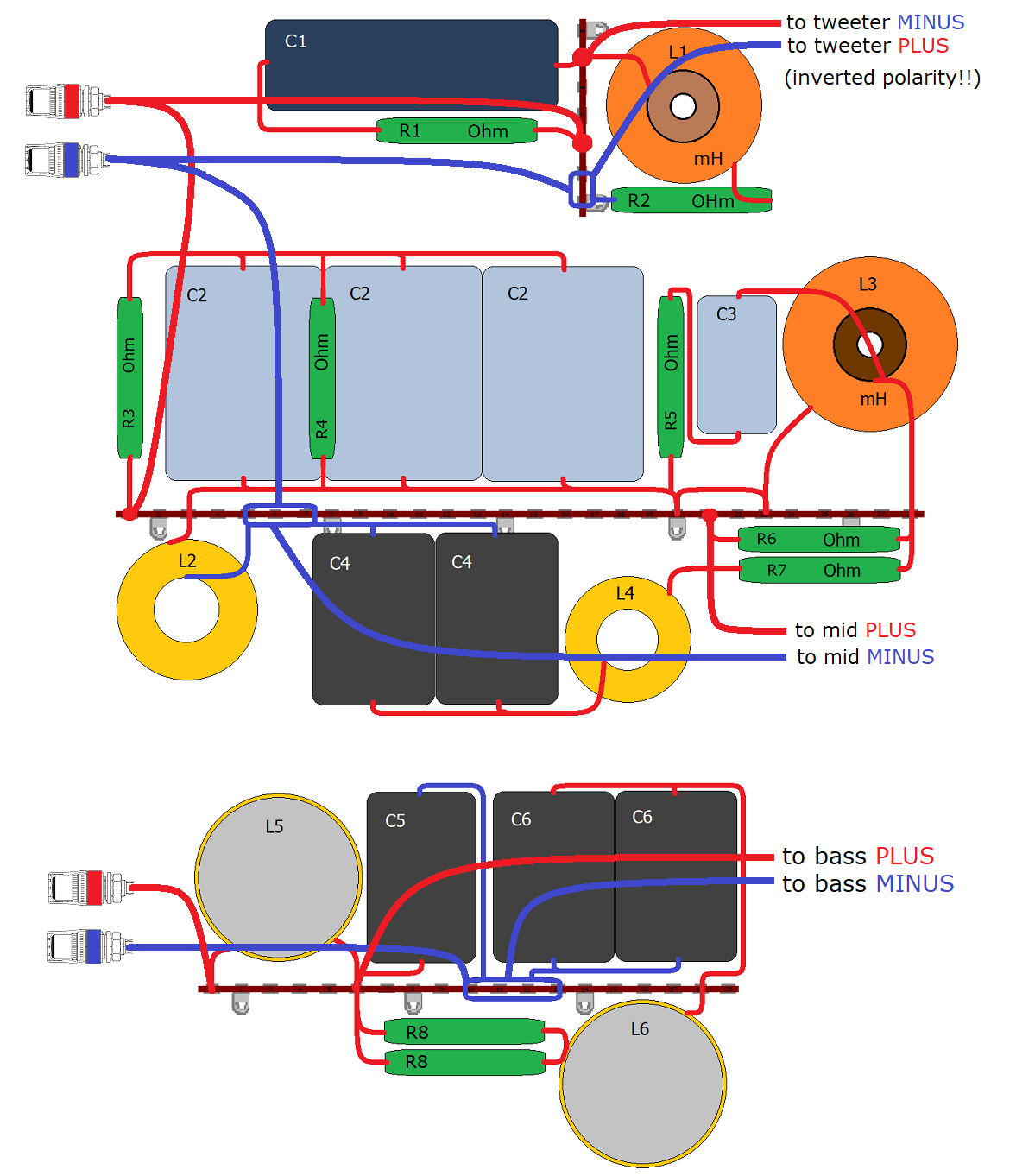
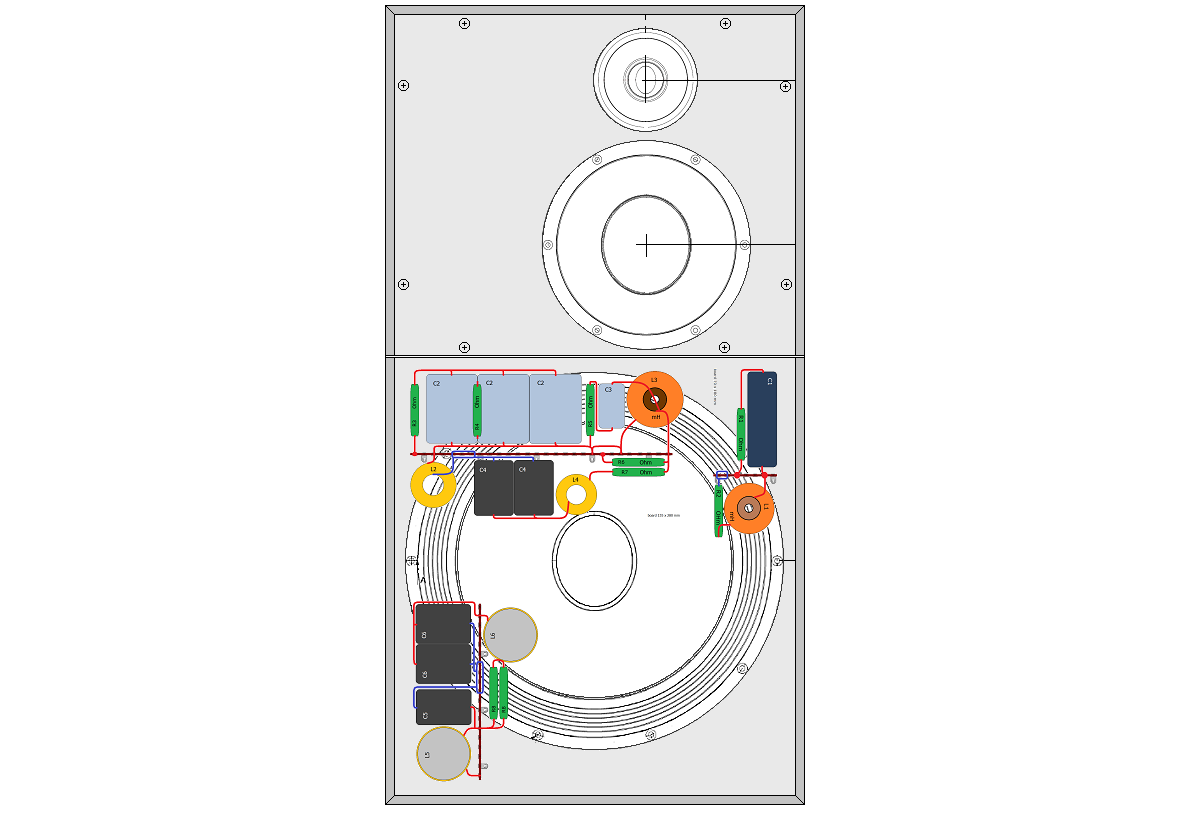
Placement of crossovers in cabinet on rear
panel. The reason for not placing the mid-tweeter sections in the
mid-tweeter compartment is to get the crossovers as far away from the
D84 magnets as possible. Believe me, the magnet structure of the D84 is
extremely strong.
The critical capacitors are all in alu tubes, thus protected from
vibration.
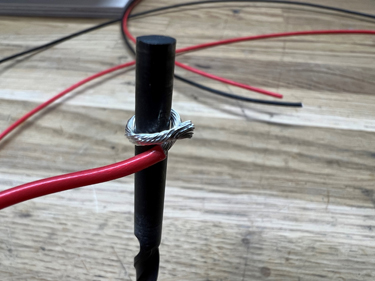
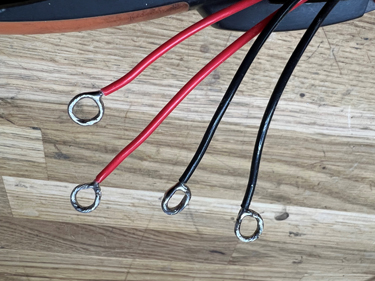
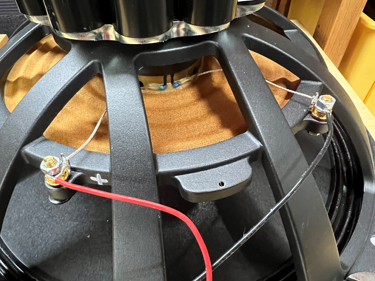
I made loops for connecting the 38WE driver.
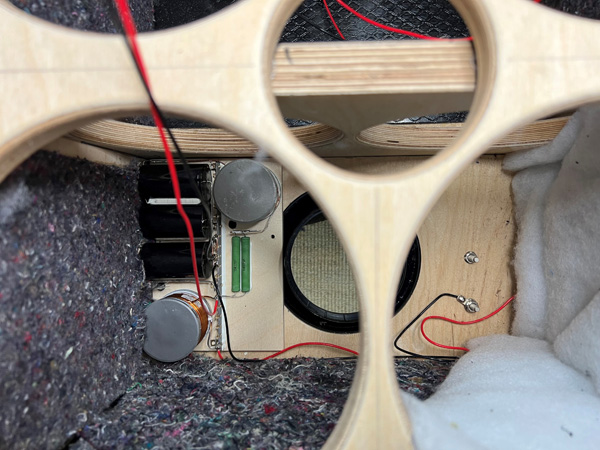
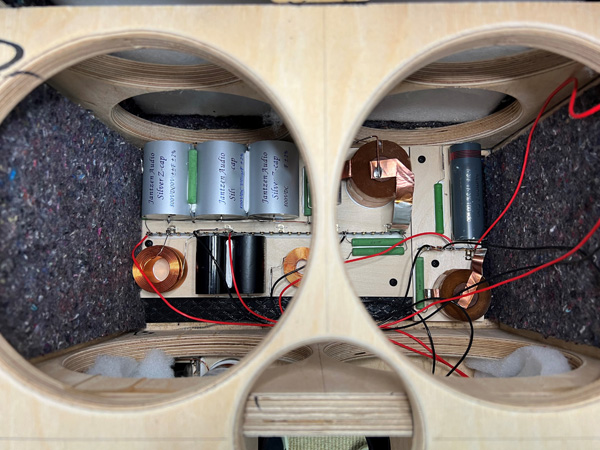
Place bass crossover next to the port and
mid+tweeter crossovers in middle section as seen on photo. This to keep
coils as far apart as possible.
Fasten boards with screws.
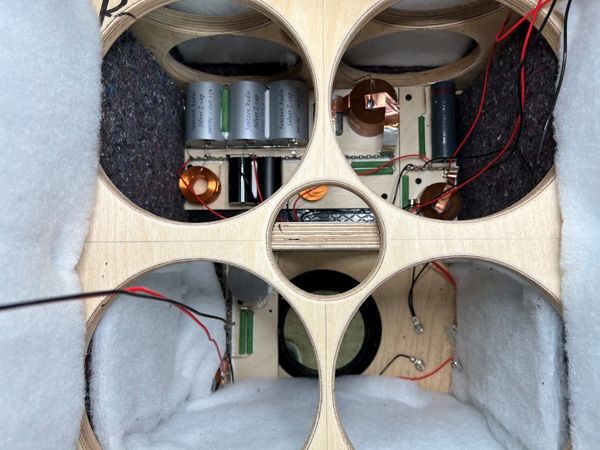
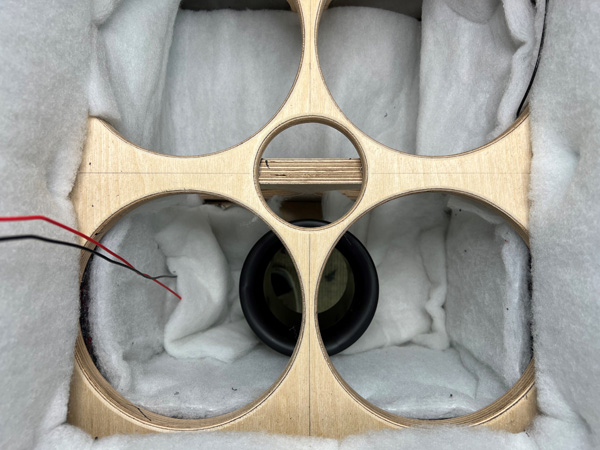
Cover bottom panel with acoustilux and add
some leftovers next to the port.
Cover mid-tweeter section as seen on photo.
The stands can be made in many ways as
long as we reach a hight of around 23-25 cm. I made my stands from
20 mm BB - and as I had 2 sets of Soundcare spikes on the shelf and
decided to finally use them.
1 meter M8 threaded rod was cut into 16 pcs 45 mm bits and I glued
them with epoxy as seen on the drawing. I wanted them not to be
visible from the outside.
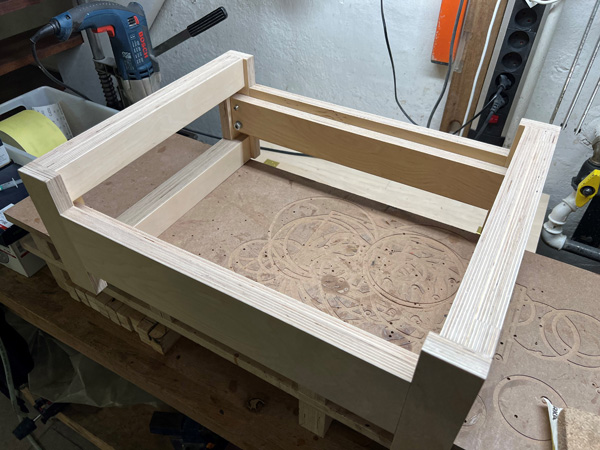
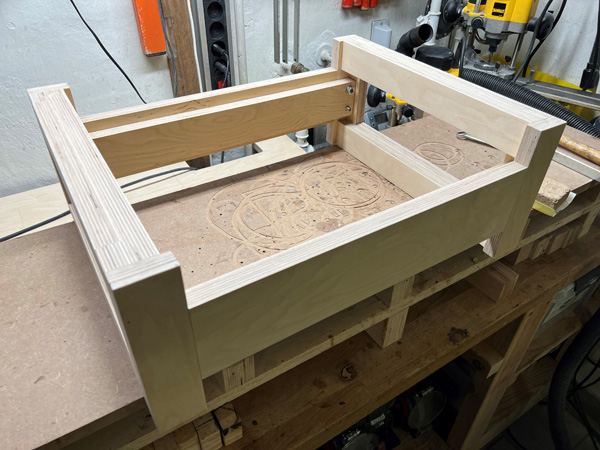
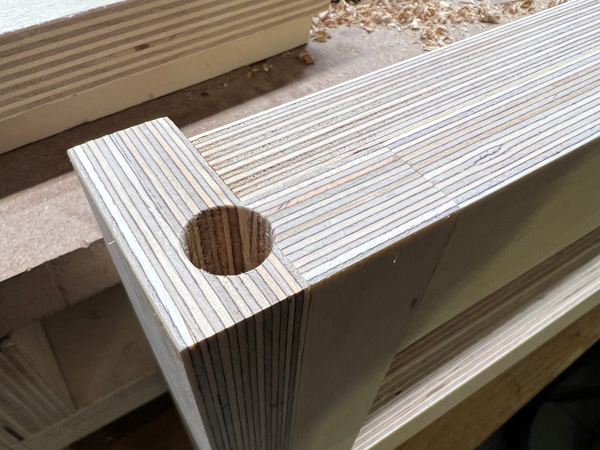
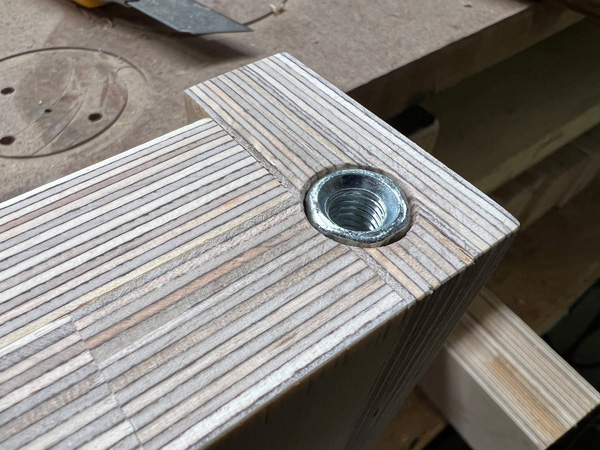
For the Soundcare spikes I bought some M8 x
30 mm threaded inserts. Threaded hex nut, I think it's called (bought at
Bauhaus).
These were 14.5 mm on their widest spot and I trimmed them a little on
my bench grinder and drilled a 14 mm holes and gently hammered them in. No
epoxy glue used here.
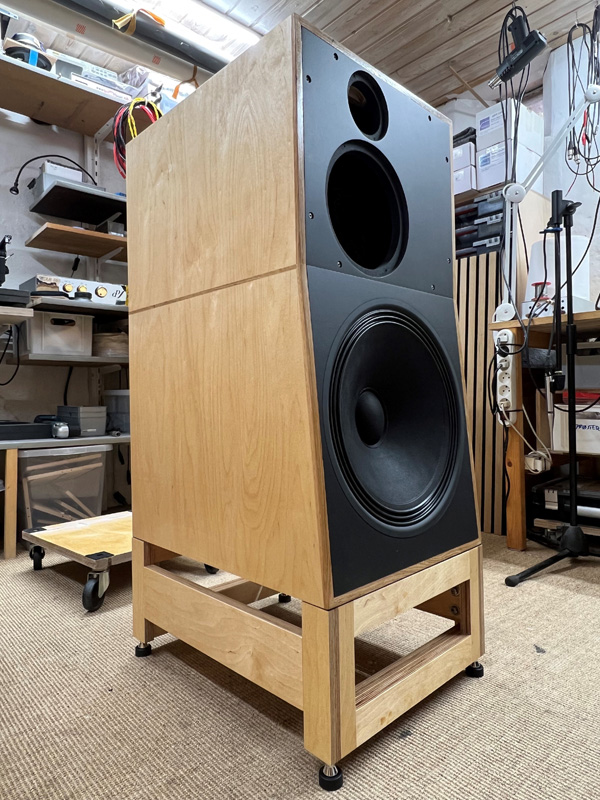
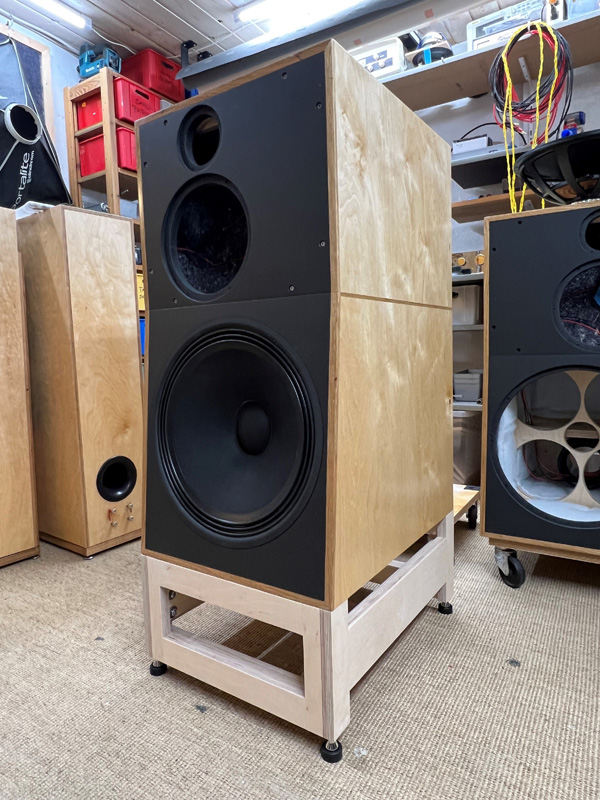
Testing my stands before and after lacquer.
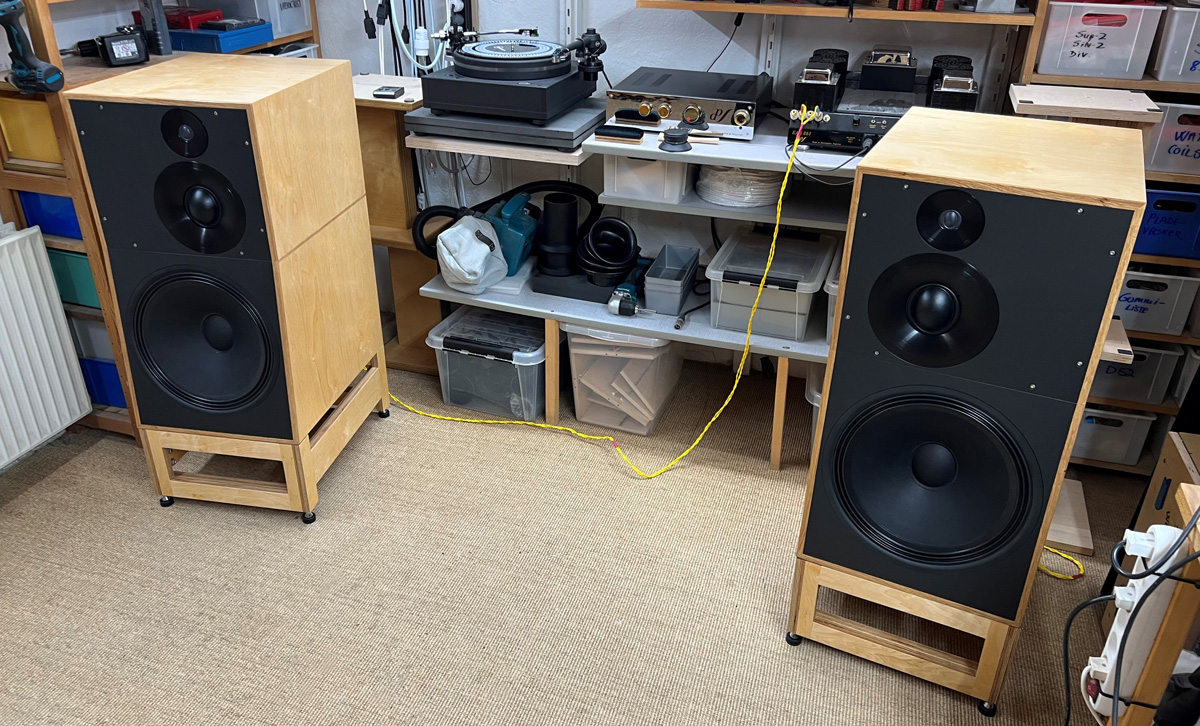
Speakers finally finished :-)
